|
|
|
|
Group 2: The short-fin gobies
pt. 2 (six-spined, fused)
Coryphopterus and Lythrypnus
|
| |
|
These two
large genera include many of the abundant
small gobies ubiquitous on and around Caribbean
reefs. They share six first-dorsal-fin spines
and 9, 10, or 11 dorsal and anal-fin elements.
The larvae of these gobies are typically
small and lightly marked, usually with only
a ventral midline series of melanophores
(at the isthmus, pelvic-fin base, anal-fin
base and caudal peduncle). The larvae of
this group and the seven-spined short-fin
gobies (Group
3) can appear similar; although, with
the characters discussed here, they should
all be able to be identified, at least to
genus.
|
|
|
|
|
|
The large
genus Coryphopterus
dominates this group of gobies and accounts
for the vast majority of gobies one sees
on a Caribbean coral reef. The largest group
within Coryphopterus are the sand
gobies. These fishes can be found perching
on the bottom along the sandy edges of hard
substrate, seemingly everywhere except in
the most turbid or muddy environments. The
sand gobies are particularly difficult to
identify to the species level in the field
and, even when in the hand, careful examination
of marking patterns is required to distinguish
the species. This becomes even more difficult
for smaller juveniles that have not developed
their species-specific marking patterns.
The other group of Coryphopterus,
the hovering masked and glass gobies, are
also very abundant, although more reef-associated.
They are found in large groups just off
the bottom on almost every coral reef in
the region.
|
|
| The Lythrypnus
gobies are much less conspicuous, but may
also be quite abundant on reefs. Their larvae
can be difficult to separate
from those of Coryphopterus |
|
|
The small
lightly-marked goby larvae account for a
major fraction of larval collections in
the region. They are superficially quite
similar, sharing the ventral midline markings
and an otherwise unremarkable appearance.
Before counting fin rays, the basic appearance
of the larvae can distinguish the three
most common genera. The larvae below are
from a typical collection: Coryphopterus
personatus in the middle, Lythrypnus
nesiotes below, and Microgobius
signatus above. The body shape of
each is distinctive: Coryphopterus
larvae tend to be hunched-over, Lythrypnus
are usually not hunched-over and
have a slightly wider body with a shorter
caudal peduncle, and larval Microgobius
are long and straight with a blunted
upward-facing mouth and a sharply-tapering
caudal peduncle.
|
|
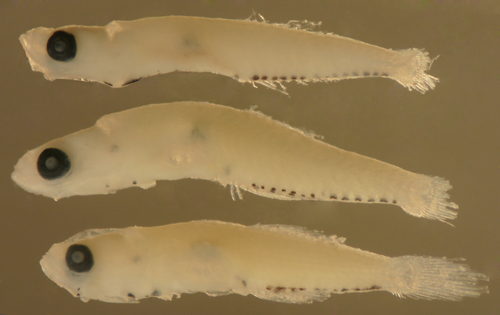 |
|
|
Note: fin-ray counts for the second dorsal
fin and the anal fin are total elements (spines
plus rays). |
|
| |
|
|
|
|
|
|
|
|
| The
large goby genus Coryphopterus contains numerous
species in the Caribbean, several of which are particularly
difficult to distinguish, sometimes even as adults.
The results of my barcode (mtDNA) sequencing for
this group show that many of the important characters
used to separate adults do not apply to larvae or
juveniles. Since the basic markings and morphology
of the early stages are shared by many of the species
in the group, DNA sequencing is likely the only
reliable way to distinguish species for most larvae
and some juveniles. |
|
| One
of the primary causes of the difficulty in identifying
juveniles and adults of Coryphopterus species
in the western Atlantic is the extreme variability
in the degree of dark markings with habitat. All
of the sand gobies have lightly-marked forms on
white sand in clear water and heavily-marked forms
on darker sediments in more turbid waters, particularly
along continental coastlines. This variation can
become extreme in several species (C.
tortugae, C.
bol, C.
eidolon, and C.
thrix), with some individuals showing almost
no dark markings at all. These super-pallid individuals
can be impossible to identify to species without
DNA sequencing. On the other hand, heavily-marked
populations of some typically pallid species, for
example C.
eidolon, have not been recognized as conspecific
and are typically assigned to other species in museum
collections. |
|
| An
additional problem when using the literature and
field-guides for identifications is the presence
of heretofore cryptic species in the common 10/10
sand-perching bridled-goby group, i.e. the recently
twice-redescribed "pallid" bridled goby C.
tortugae and a new more-offshore species
C. bol
(Victor
2008). These species are presently lumped by
most observers as variants of the bridled goby C.
glaucofraenum. To avoid confusion, I propose
that C.
glaucofraenum retain the original "bridled
goby" common name, while C.
tortugae should be called the "patch-reef
goby" and C.
bol should be called the "sand-canyon goby",
after their distinctive habitats.
|
|
| Most
of the characters traditionally used to separate
sand gobies do not apply to juvenile or larval stages.
For example, the morphology of the pelvic fin is
one of the more important taxonomic characters separating
the regional Coryphopterus species. The degree
of joining of the pelvic fins, the relative length
of the innermost ray, and the presence or absence
of the pelvic frenum are diagnostic for some adult
Coryphopterus (the pelvic-fin frenum is the
anterior membrane running from spine to spine that
forms the fin into a sucking disk). My DNA barcoding
results, however, reveal that pelvic-fin characters
do not apply to larvae, recruits, or even small
juveniles of several species. For example, the species
with divided pelvic fins have fused pelvic fins
as larvae and small juveniles (i.e. C.
alloides, C.
personatus, C.
hyalinus, and C.
lipernes). The pelvic frenum can be present
in juveniles of species that later do not have one
(C.
dicrus) and the innermost pelvic-fin rays
do not become distinctly shorter or longer until
well after the transitional stage. |
|
| Transitional
sand gobies can develop their metamorphic melanophores
in differing sequences, leading to a proliferation
of transitional larval types that certainly represent
the same species. At least some of this variation
may reflect the marked variability in the degree
of markings with habitat types, with lightly-marked
juveniles living on white sand and those on darker
backgrounds or more turbid waters being heavily-marked.
The light marking may occur in larvae as well, where
a significant portion of individuals are missing
the melanophores on the caudal-fin base and/or the
dorsal caudal peduncle. If these patterns prove
to occur within the same species, it raises a very
interesting question whether larvae have pre-determined
which habitat to settle onto or the trait is flexible. |
| |
|
The reported fin-ray counts for
the genus Coryphopterus in the literature:
|
|
|
species: #dorsal/#anal-fin elements #pectoral
rays (pelvic-fin form), sand or other goby
|
| |
|
The Sand Gobies
|
|
10/10 group
(widespread and abundant species)
C.
glaucofraenum: Randall: 10/10 pect 17-20
Bohlke: 10/10, rare 9 pect 17-20 usu 19
C.
tortugae: Acero: 10/10 pect 18-20
C. bol:
Victor
2008: 10/10 pect 18-20
C.
eidolon: Randall: 10 (11 is a typo)/9-10,
mode 10 pect 19-20, rare 18 Bohlke: 10/10,
rare 9 pect 19-20
C.
thrix: Bohlke: 9-10/10 pect 17-19
C.
dicrus: Randall: 10/10 pect 18-20 Bohlke:
10/10 pect 18-20
11 group
(localized endemics)
C.
punctipectophorus: Bohlke: 11/10 pect
18-20 (South Carolina to the Gulf of Mexico)
C.
venezuelae: Cervigon: 11/11 pect 18-20
(NE Venezuela: Cubagua, Isla Margarita, and Cumana)
fewer than 10
(widespread, but notably uncommon)
C.
kuna: 9/9 pect 15
C.
alloides: 10/9 Bohlke: 10, rare
9/9, rare 8 pect 16-17 (divided pelvic fins)
|
|
|
The Reef Gobies
|
|
C.
lipernes: 10/10 pect 16-18 (divided pelvic
fins)
C.
hyalinus: 10/10 pect 14-16 (divided pelvic
fins)
C.
personatus: Randall: 11/11 pect 14-16
(occ. 10/10) Bohlke: 10-11, mode 11/10-11,
mode 11 pect 14-16 (divided pelvic fins)
|
|
|
| |
|
|
|
|
|
Coryphopterus
larvae
the "sand gobies"
|
|
|
|
|
|
|
| |
|
|
| Most
of the Coryphopterus species are sand gobies,
i.e. small sand-perching gobies with pale bodies
and a set of dark stripes and spots. There are numerous
species and larvae cannot confidently be identified
to the species level without DNA sequencing. Fin-ray
counts can distinguish the sand-goby species with
fewer or more than 10 dorsal and anal-fin elements,
but many of the species and the vast majority of
specimens share the 10/10 fin-ray count. The non-sand
species comprise C.
lipernes, a colorful coral-dwelling species,
and C.
personatus and C.
hyalinus, both colorful hovering gobies
that school in groups over corals and sponges. The
sand and non-sand species are similar as larvae
and share a suite of larval characters, but can
be distinguished. |
|
|
Analogues: (VMS4:
jaw angle, thorax, anal fin, caudal peduncle)
The basic larval melanophore patterns on the sand
gobies are shared with a number of other gobies,
although, in general, these others do not have
equal numbers of dorsal and anal-fin elements
as do most of the sand goby species. Coryphopterus
personatus larvae do have the equal numbers
of fin elements, but are missing the melanophores
at the jaw angle and at the caudal-fin base and
have a larger eye. Larval Lythrypnus
appear quite similar, but have 10/9,
are shorter and wider, have fewer procurrent caudal-fin
rays, and transition at a smaller size. Lophogobius
cyprinoides may share the VMS4 pattern,
but have 10/9 and fewer procurrent caudal-fin
rays. Bathygobius
larvae have 10/9 and VMS4, but have distinctive
internal melanophores not present on larval Coryphopterus
The seven-spined
gobies with similar larvae do not have the
jaw angle melanophores and the caudal peduncle
streak extends only halfway to the caudal fin.
|
|
| Description:
Body relatively thin, long and narrow with a large
eye and a terminal mouth. Paired fins medium to
long at transition, dorsal and anal-fin bases relatively
short, caudal peduncle long and narrow, procurrent
caudal-fin rays 7-10 (7-8 spindly). Lightly marked
mostly along the lower body: melanophores on the
ventral midline at the isthmus and the pelvic-fin
insertion (usually streaks). Rare variants have
a melanophore on the abdominal midline promontory
just forward of the vent. There is a row of melanophores
along the anal-fin base, usually five, paired and
one per side between the third and eighth element
(often merged into a streak on each side). Then,
after a space, there is a row of midline melanophores,
usually seven or eight unpaired (but often merged
into a streak) extending along the ventral caudal
peduncle ending near the start of the procurrent
caudal-fin rays. Melanophores are typically present
on the base of several (usually 4 or 5) of the lower
segmented caudal-fin rays extending up to halfway
out along the rays. The majority of larvae have
one (often none or two, occasionally three or four)
melanophores on the dorsal midline just after the
last dorsal-fin ray (proportions vary greatly between
collections). Some have an additional small melanophore
off-center of the dorsal midline near the base of
some of the mid-soft-dorsal-fin rays. Many (all?)
have melanophores on the distal membranes between
the anal-fin rays, usually between the second and
sixth elements. Internal melanophores are present
at the base of the saccule and often above the saccule
and sometimes several around the rear braincase,
along the dorsal surface of the swim bladder, and
around the gut near the vent. Most individuals have
a melanophore at the angle of the jaw, however less-developed
larvae are often missing them (but they do have
caudal-fin melanophores, separating them from C.
personatus). |
|
| Early-stage
larvae before the completion of all of the fin elements
have a dorsal and ventral indentation in the iris,
with some later-stage larvae retaining a dorsal
indentation in the iris. Series of transitional
larvae show development of the eye from a moderately-narrowed
vertical oval, often somewhat squared-off, with
a small posterior-inferior extension of the iris,
to round. The extension has no surface melanophores
overlying it, or, at most, a single small melanophore
at the dorsal edge (vs. C.
personatus, see comparative photograph under
C.
personatus). Rare individuals show abnormal
enlargements of this extension (interestingly, often
several in the same collection).
There is often a prominently speckled "eyebrow"
membrane over the upper half and posterior of the
eyeball that appears detached from the pigmented
iris below. |
|
| Although
the length of the pelvic rays are an important character
as adults, larvae and juveniles typically have the
innermost pelvic-fin ray slightly shorter or about
equal in length to the next ray. The pelvic frenum
is not usually visible, but may develop on all juveniles
in the group (see C.
dicrus). Larvae have fused pelvic fins,
and the species with divided pelvic fins likely
develop the division after transition (unknown for
C.
alloides, but confirmed for C.
lipernes and C.
personatus). |
|
| |
|
|
| Coryphopterus
sp. 10/10 larva |
| 4.2 mm SL |
| early-stage with rounded
eye |
| San Blas, Panama, SB86-927 |
|
 |
| Coryphopterus
sp. 10/10 larva |
| 6.5 mm SL |
early stage with narrow
eye
and dorsal iris indentation |
| San Blas, Panama, SB86-512 |
|
 |
| Coryphopterus
sp. 10/10 larva |
| 7.2 mm SL |
| with slightly narrowed
eye |
| San Blas, Panama, SB86-426 |
|
 |
| |
 |
| Coryphopterus
sp. 10/10 larva |
| 7.4 mm SL |
| with round eye |
| San Blas, Panama, SB86-426 |
|
 |
| |
 |
| Coryphopterus
sp. 10/10 larva |
| 7.2 mm SL |
squarish eye, membrane
above eyeball,
braincase melanophores (left-sided visible) |
| San Blas, Panama, SB87-219 |
|
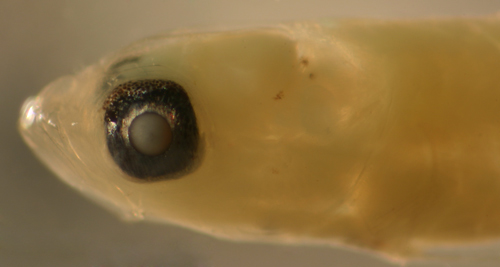 |
| |
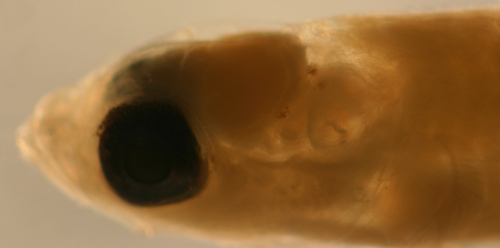 |
| Coryphopterus
sp. 10/10 larva |
| 7.3 mm SL |
| speckled membrane above
eyeball |
| San Blas, Panama, SB86-1103 |
|
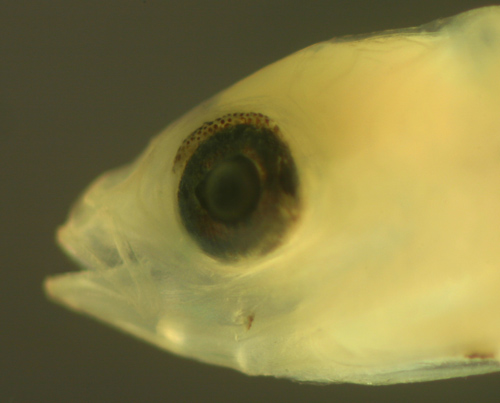 |
| Coryphopterus
sp. 10/10 larva |
| 7.5 mm SL |
| with anal-fin ray membrane
melanophores |
| San Blas, Panama, SB86-1124 |
|
 |
| Coryphopterus
sp. 10/10 larva |
| 6.6 mm SL |
innermost pelvic-fin
ray equal to next,
with abdominal promontory melanophore |
| San Blas, Panama, SB86-1103 |
|
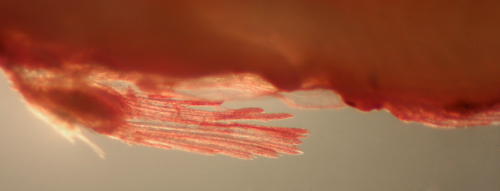 |
| Coryphopterus
sp. 10/10 larva |
| 5.9 mm SL |
| internal melanophores |
| San Blas, Panama, SB86-404 |
|
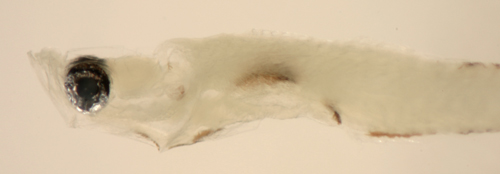 |
| Coryphopterus
sp. 10/10 larva |
| 6.3 mm SL |
| small and thin, but
with round eye |
| San Blas, Panama, SB84-522 |
|
 |
| |
 |
| Coryphopterus
sp. 10/10 larva |
| 7.0 mm SL |
| Barbados, HV 8-04-02
SB86-805 |
|
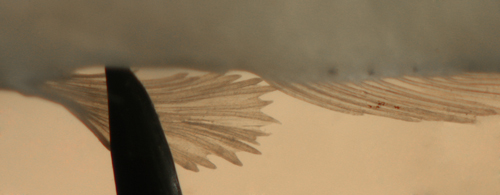 |
| Coryphopterus
sp.
10/10 larva |
| 6.6 mm SL |
| San Blas, Panama, SB86-805 |
|
 |
| |
 |
| Coryphopterus
sp. 10/10 larva |
| 8.6 mm SL |
| large-sized, extreme
one percent |
| San Blas, Panama, SB86-805 |
|
 |
| Coryphopterus
sp. 10/10 larva |
| 7.0 mm SL and 7.1 mm
SL |
variant with melanophore
on promontory
forward of vent, pect-18 |
| San Blas, Panama, SB86-1004 |
|
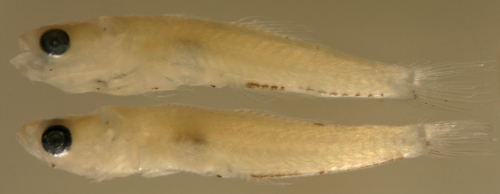 |
| |
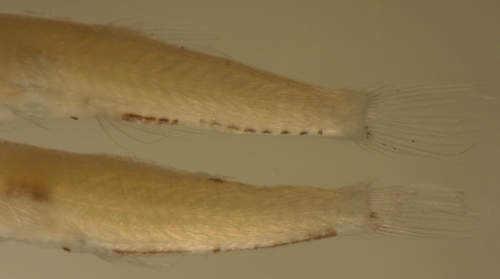 |
| |
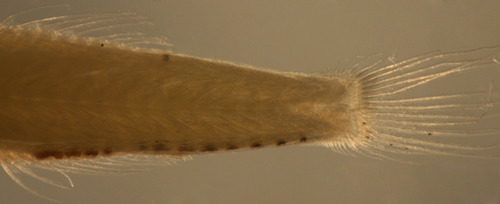 |
| Coryphopterus
sp. 10/10 transitional larva |
| 6.3 mm SL |
| San Blas, Panama, SB83-151 |
|
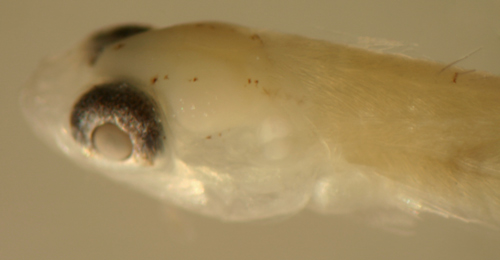 |
| Coryphopterus
sp. 10/10 transitional larva |
| 6.6 mm SL |
transitional variant?
no anal-fin base or caudal-fin melanophores:
D-VI,10 A-10 Pect-18 |
| Banco Chinchorro, Mexico,
coll. D. Jones |
|
 |
| Coryphopterus
sp. 10/10 transitional larva |
| 7.6 mm SL |
| San Blas, Panama, SB86-426 |
|
 |
| |
 |
| |
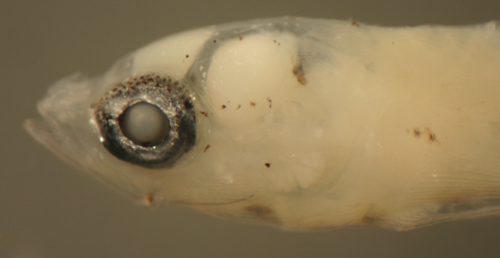 |
| |
 |
| |
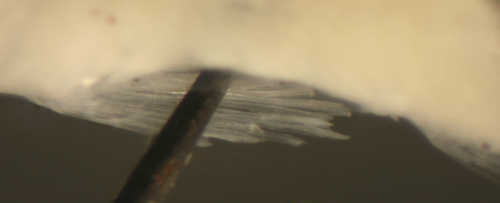 |
| Coryphopterus
sp. 10/10 transitional larva |
| 7.2 mm SL |
| San Blas, Panama, SB86-424 |
|
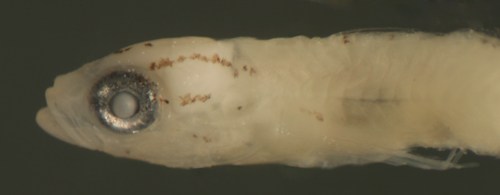 |
| Coryphopterus
sp. 10/10 transitional larva |
| 6.6 mm SL |
| typical type, head
iridophore pattern |
| San Blas, Panama, SB86-416 |
|
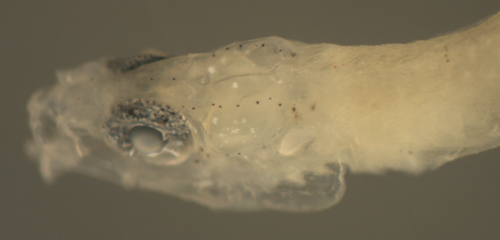 |
| Coryphopterus
sp. 10/10 transitional larva |
| 6.6 mm SL |
| note head neuromasts
developing |
| San Blas, Panama, SB86-1010 |
|
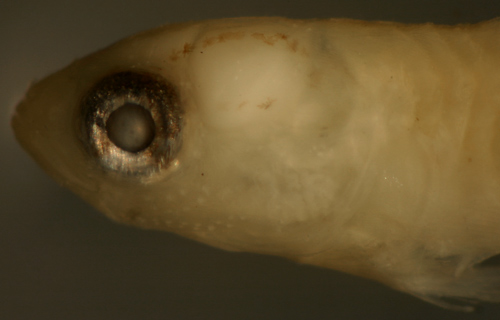 |
| Coryphopterus
sp. 10/10 transitional larva |
| 8.6 mm SL |
transitional variant,
the only dorsal body
melanophores along first-dorsal-fin spine
D-VI,10 A-10 Pect-19 |
| San Blas, Panama, SB86-627a |
|
 |
| Coryphopterus
sp. 10/10 larva |
| abnormal posterior
extension of the iris |
| San Blas, Panama, SB83-151 |
|
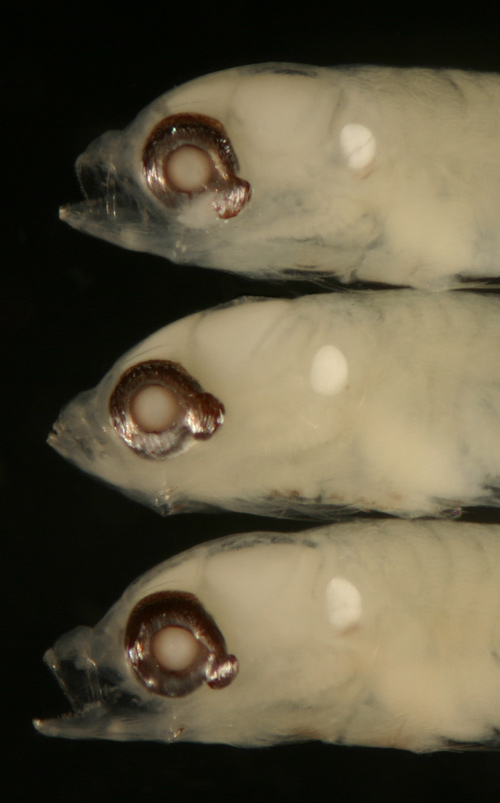 |
|
|
|
|
|
| Coryphopterus glaucofraenum |
|
|
|
|
|
|
| |
|
|
| Diagnosis:
Modal fin-ray counts of D-VI,10 A-10 and
Pect-18-20 with fused pelvic fins indicate the 10/10
Coryphopterus sand gobies, i.e.
Coryphopterus glaucofraenum, C.
tortugae, C.
bol, C.
dicrus, C.
eidolon, and C.
thrix. Some of the the distinguishing features
of adult
C. glaucofraenum are not present
on recruits and small juveniles. |
|
| Analogues:
The 10/10 sand goby clade share fin-ray counts,
morphology, and most markings as larvae and new
recruits. C. glaucofraenum and the other
head-striped sand gobies develop short stripes on
top of the head very early in transition, separating
them from the spotted-head gobies (i.e. C.
eidolon, C.
thrix, C.
alloides, C.
kuna, and the non-sand
Coryphopterus species). C. glaucofraenum
diverge early from the other head-striped gobies
(C.
tortugae, C.
bol, and C.
dicrus) when they develop colon-like rounded
spots at the base of the caudal fin. In addition,
they develop melanophores at about 7-8 o'clock on
the orbital rim extending straight forward in a
stripe (not obliquely down) across the upper jaw
vs. a cluster at 6-7 o'clock in C.
tortugae and C.
bol. In Venezuela, C.
venezuelae develops almost identical markings
to C. glaucofraenum (but have 11/11 fin elements),
diverging only in the juvenile stage. |
|
| Description:
Transitional recruits develop three short
stripes behind the eye with the lowest stripe extending
forward of the eye to the tip of the jaw, but notably
not continuous under the eyeball (until larger juveniles).
Lightly-marked transitional recruits can have only
a single melanophore or two at the 7-8 o'clock position
on the orbital rim (they have all of the stripes
behind the eye). Pigmentation of the body develops
more slowly, as a lateral midline row of spots,
then an upper body row. The midline spots become
X-shaped later. The two colon-like rounded spots
at the base of the caudal fin are present early
and typically have a linear trail of melanophores
onto the fin rays. A chain-like pattern of large
deep melanophores develop within the musculature
of the tail. |
|
| NOTE:
Pre-transitional larvae are described above
as the 10/10 Coryphopterus spp. |
|
|
| Coryphopterus
glaucofraenum recruits |
| 8.1 and 7.0 mm SL,
DNA confirmed ID |
| Colon, Panama, N7527b |
|
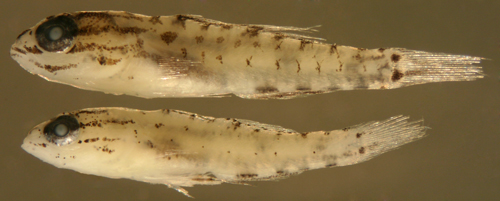 |
| Coryphopterus
glaucofraenum recruits |
| 8.4, 9.0, 10.2 mm SL,
DNA confirmed ID |
| Colon, Panama, N7527b |
|
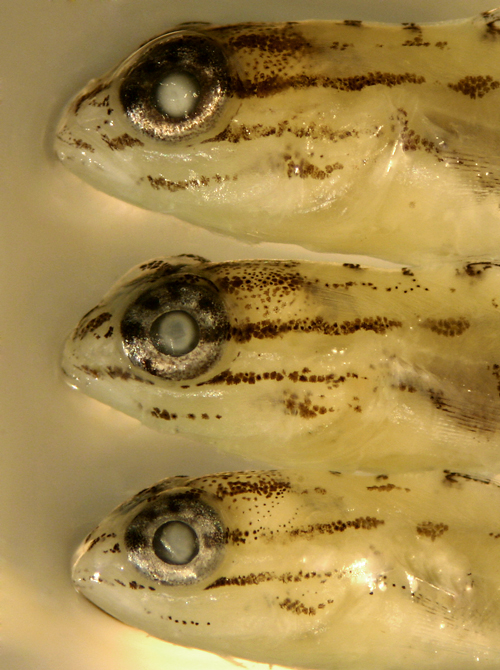 |
| Coryphopterus
glaucofraenum recruit |
| 7.0 mm SL, DNA confirmed
ID |
| Colon, Panama, N7527b |
|
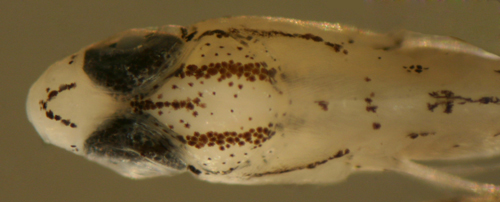 |
| Coryphopterus
glaucofraenum juvenile |
| 8.1 mm SL, DNA confirmed
ID |
| Colon, Panama, N7527b |
|
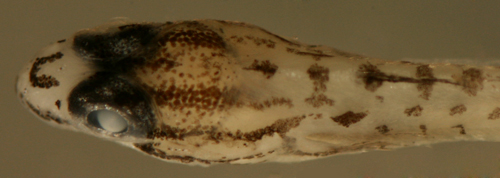 |
| Coryphopterus
glaucofraenum recruit |
| 9.2 mm SL, 10/10 fin
elements |
| Cumana, Venezuela,
GCRL 15947 |
|
 |
|
|
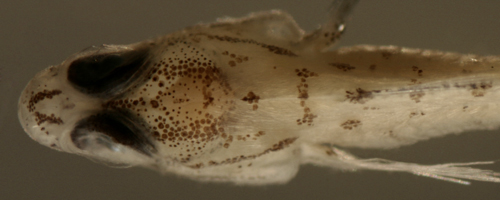 |
| Coryphopterus
glaucofraenum juveniles |
| 12.6 and 13.7 mm SL |
| basicaudal colon spots,
bridging |
| Colon, Panama, N7527b |
|
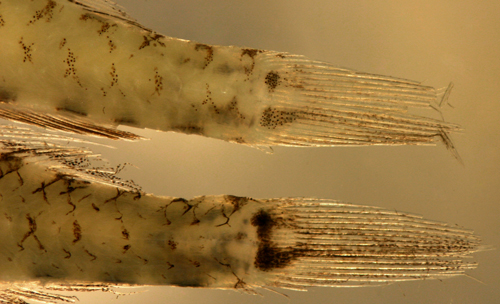 |
| Coryphopterus
glaucofraenum recruit |
| 13.1 mm SL, DNA confirmed
ID |
| pallid, lower-eye stripe,
8 o'clock spot |
| St. Thomas, USVI, ST307 |
|
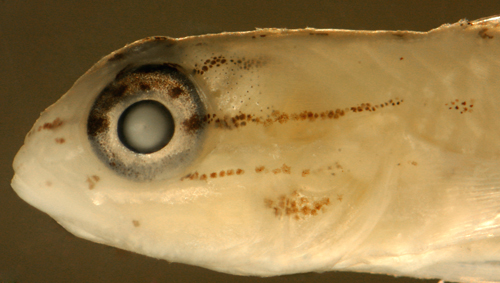 |
| Coryphopterus
glaucofraenum juvenile |
| 12.9 mm SL |
| San Blas, Panama, SB82-054 |
|
 |
|
|
|
|
|
|
|
|
| Diagnosis:
Modal fin-ray counts of D-VI,10 A-10 and
Pect-18-20 with fused pelvic fins indicate the 10/10
Coryphopterus sand gobies, i.e.
Coryphopterus tortugae, C.
glaucofraenum, C.
dicrus, C.
eidolon, and C.
thrix. The distinguishing features of adult
C. tortugae are mostly not present
on recruits and small juveniles. |
|
| Analogues:
The 10/10 sand goby clade share fin-ray counts,
morphology, and most markings as larvae and new
recruits. C. tortugae and the other head-striped
sand gobies develop short stripes on top of the
head very early in transition, separating them from
the spotted-head gobies (i.e. C.
eidolon, C.
thrix, C.
alloides, C.
kuna, and the non-sand
Coryphopterus species). C.
tortugae begin to diverge when they develop
a cluster of melanophores below the eye at 6-7 o'clock
on the orbital rim (i.e. under the anterior pupil)
vs. at 7-8 o'clock (and then continuing as a line
across the upper jaw to the tip) on C.
glaucofraenum. C.
bol share the cluster under the eye and
only diverge from C. tortugae when they develop
melanophores on the lower third of the pectoral-fin
base (absent on C. tortugae) and then a complete
long upper eye-stripe (broken on C. tortugae);
note that these long surface eye stripes overlie
the short eye stripes of the transitional stage.
C. tortugae develop a basicaudal bar, notably
without the rounded colon-like spots on the base
of the caudal fin as seen on C.
glaucofraenum. |
|
| Description:
|
|
| NOTE:
Pre-transitional larvae are described above
as the 10/10 Coryphopterus spp. |
|
|
|
|
|
|
|
|
|
|
| Diagnosis:
Modal fin-ray counts of D-VI,10 A-10 and
Pect-18-20 with fused pelvic fins indicate the 10/10
Coryphopterus sand gobies, i.e.
Coryphopterus bol, C.
glaucofraenum, C.
tortugae, C.
dicrus, C.
eidolon, and C.
thrix. The distinguishing features of adult
C. bol are mostly not present
on recruits and small juveniles. |
|
| Analogues:
The 10/10 sand goby clade share fin-ray counts,
morphology, and most markings as larvae and new
recruits. C. bol and the other head-striped
sand gobies develop short stripes on top of the
head very early in transition, separating them from
the spotted-head gobies (i.e. C.
eidolon, C.
thrix, C.
alloides, C.
kuna, and the non-sand
Coryphopterus species). C.
bol begin to diverge when they develop a cluster
of melanophores below the eye at 6-7 o'clock on
the orbital rim (i.e. under the anterior pupil)
vs. at 7-8 o'clock (and then continuing as a line
across the upper jaw to the tip) on C.
glaucofraenum. C.
tortugae share the cluster under the eye,
and C. bol only diverge from C.
tortugae when they develop melanophores
on the lower third of the pectoral-fin base (absent
on C.
tortugae) and then a complete long upper
eye-stripe (broken on C.
tortugae); note that these long surface
eye stripes overlie the short eye stripes of the
transitional stage. C. bol develops a basicaudal
bar, notably without the rounded colon-like spots
on the base of the caudal fin as seen on C.
glaucofraenum. |
|
| Description:
Transitional stage C. bol first develop
short head stripes at the dorsal interorbital midline
and behind the upper eye and mid-eye. The body is
mostly unmarked and the larval melanophores at the
jaw angle, thoracic ventral midline, and caudal
fin disappear. The larval melanophores along the
base of the anal fin and the ventral midline of
the caudal peduncle persist through transition.
Melanophores develop along the bases of the dorsal-fin
spines and speckle the membranes of the dorsal and
anal fins. The pectoral, pelvic, and caudal fins
are unmarked.Internal melanophores are present over
the dorsal peritoneum. |
|
| NOTE:
Pre-transitional larvae are described above
as the 10/10 Coryphopterus spp. |
|
|
| Coryphopterus
bol transitional recruit |
| 7.7 mm SL |
| short head stripes
of the transitional stage |
| La Parguera, Puerto
Rico, PR785a |
|
 |
| Coryphopterus
bol transitional recruits |
| 7.7, 8.0, 9.3 mm SL |
| short head stripes
of the transitional stage |
| La Parguera, Puerto
Rico, PR785a |
|
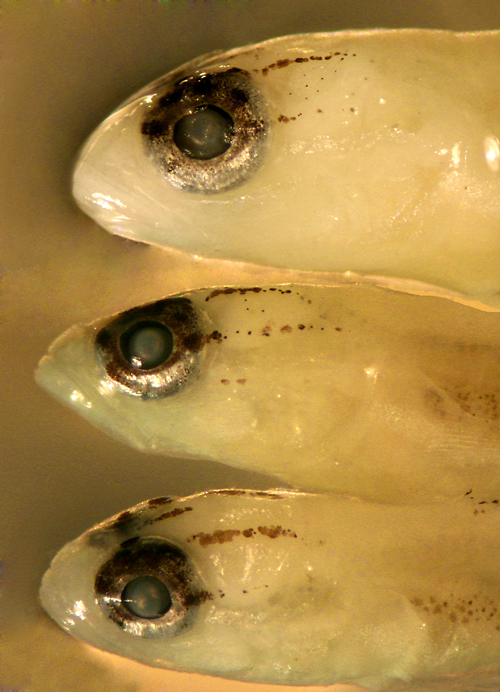 |
| Coryphopterus
bol recruit |
| 8.0 mm SL, DNA confirmed
ID |
| cluster at 7 o'clock,
under pupil |
| Colon, Panama, N7530a |
|
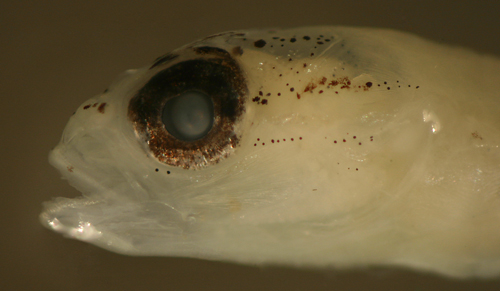 |
| Coryphopterus
bol recruits |
| 11.0-11.9 mm SL, DNA
confirmed ID |
| stripe to 6-7 o'clock,not
linear to jaw tip |
| lower pectoral base
spot |
| complete upper eye
stripe |
| Colon, Panama, N7530a |
|
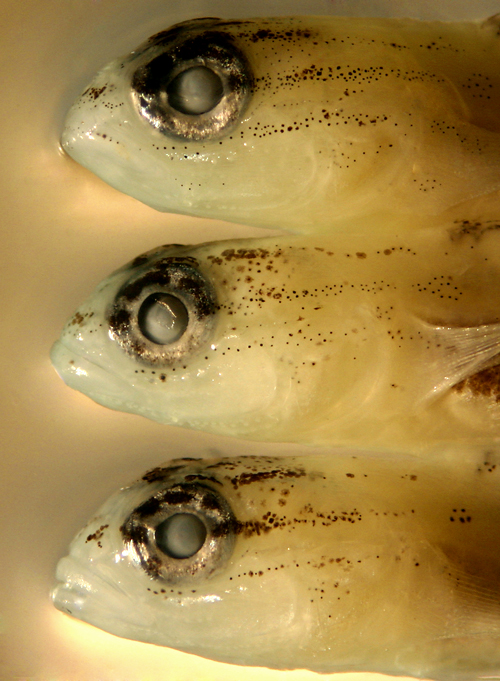 |
|
|
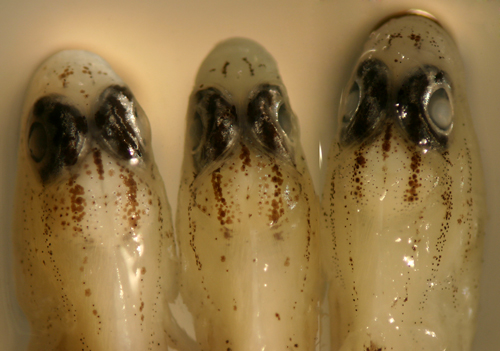 |
| Coryphopterus
bol transitional recruits |
| 9.0 and 9.5 mm SL,
DNA confirmed ID |
| innermost pelvic-fin
ray equal to next |
| Noronha, Brazil, FN01 |
|
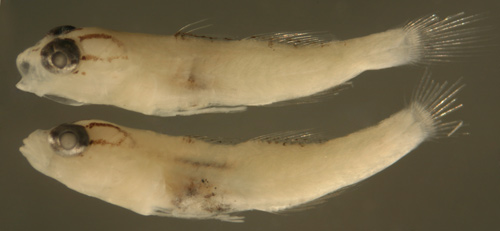 |
| |
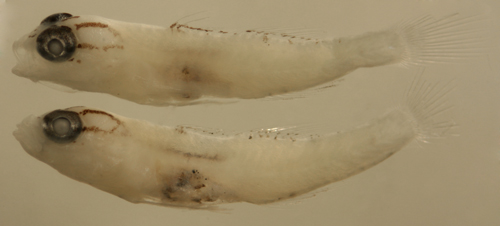 |
Coryphopterus
bol
late transitional recruit |
| 7.4 mm SL |
| Barbados, V05-R20,
coll. H. Valles |
|
 |
| Coryphopterus
bol |
| 7.9 mm SL |
| San Blas, Panama, SB82-050 |
|
 |
| Coryphopterus
bol juvenile |
12.5 mm SL, DNA confirmed
ID |
| Noronha, Brazil FN01 |
|
 |
| Coryphopterus
bol juveniles |
| 12.5 to 15.1 mm SL,
DNA confirmed ID |
no stripe on lower
cheek and
equal innermost and next pelvic-fin rays |
| Noronha, Brazil FN01 |
|
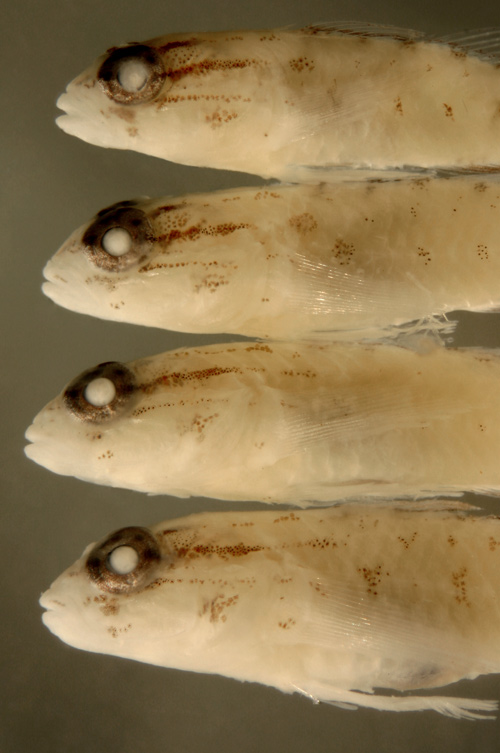 |
| |
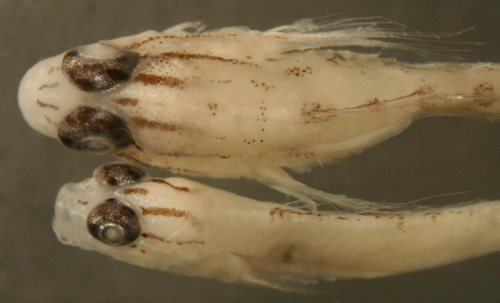 |
| |
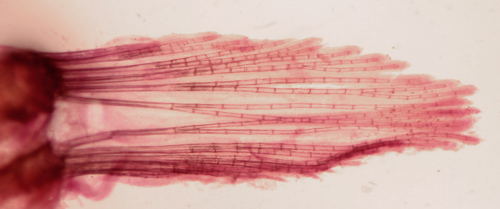 |
| Coryphopterus
bol juvenile |
| 22.5 mm SL, DNA confirmed
ID |
| lower pectoral base
spot, complete upper-eye stripe, no 7-8 o'clock
bar or stripe |
| Panama, n7530a |
|
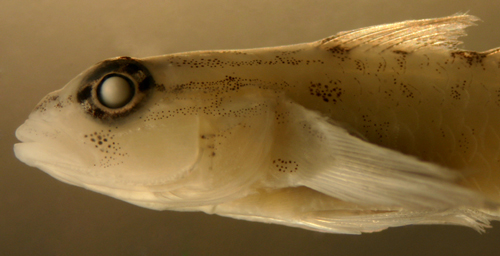 |
| |
|
|
|
|
|
|
|
|
|
| Diagnosis:
Modal fin-ray counts of D-VI,10 A-10 and
Pect-18-20 with fused pelvic fins indicate the 10/10
Coryphopterus sand gobies, i.e.
Coryphopterus dicrus, C.
glaucofraenum, C.
tortugae, C.
bol, C.
eidolon, and C.
thrix. The distinguishing features of adult
C. dicrus are mostly not present
on recruits and small juveniles. |
|
| Analogues:
The 10/10 sand goby clade share fin-ray counts,
morphology, and most markings as larvae and new
recruits. C. dicrus and the other head-striped
sand gobies develop short stripes on top of the
head very early in transition, separating them from
the spotted-head gobies (i.e. C.
eidolon, C.
thrix, C.
alloides, C.
kuna, and the non-sand
Coryphopterus species). Transitional
C. dicrus diverge |
|
| Description:
|
|
| NOTE:
Pre-transitional larvae are described above
as the 10/10 Coryphopterus spp. |
|
|
| Coryphopterus
dicrus juvenile, DNA ID |
| 11.0 mm SL |
| distinct frenum present |
| Barbados, HV 8-02-02 |
|
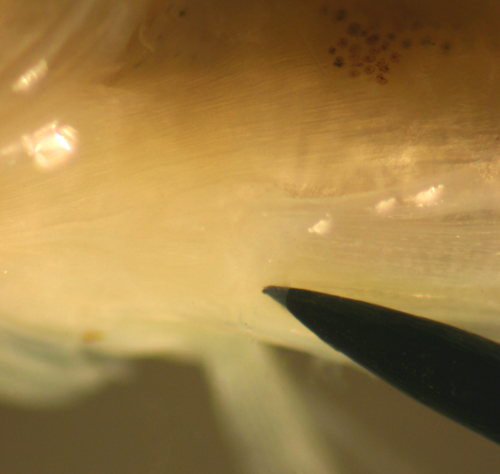 |
| Coryphopterus
dicrus juvenile |
| 14.5 mm SL |
stripe on lower cheek
colon-like spots on pectoral axil |
| San Blas, Panama, SB82-058 |
|
|
|
|
|
|
|
|
|
|
| Diagnosis:
Modal fin-ray counts of D-VI,10 A-10 and
Pect-18-20 with fused pelvic fins indicate the 10/10
Coryphopterus sand gobies, i.e.
Coryphopterus eidolon, C.
glaucofraenum, C.
tortugae, C.
bol , C.
dicrus, and C.
thrix. The distinguishing features of adult
C. eidolon are mostly not present
on recruits and small juveniles. |
|
| Analogues:
The 10/10 sand goby clade share fin-ray counts,
morphology, and most markings as larvae and new
recruits. Transitional C. eidolon and C.
thrix develop scattered spots on the top
of the head vs. short stripes on most other sand
gobies, as well as a prominent melanophore(s) at
the 7-8 o'clock position on the orbital rim, often
early in transition. Both species have no jaw angle
melanophores, at least as recruits (larval pattern
uncertain). C.
thrix juveniles larger than about 12 mm
SL diverge from C. eidolon as they develop
the characteristic speckling of small patches of
melanophores (some 0.05-0.1 mm) over the dorsal
aspect of the eye vs. a few large round and comma-shaped
patches (0.3-0.5 mm) in C. eidolon (and other
sand gobies). An additional difference between the
small juveniles (>10 mm SL) of these two very
similar species is the uniform size of the head
melanophores in C. eidolon vs. C.
thrix, where the lowest melanophores, just
behind the eye, are larger than the adjacent sets
of dorsal melanophores. Transitional recruits of
the hovering gobies Coryphopterus
personatus, C.
hyalinus, and C.
lipernes also do not have the stripes on
the head at transition; nevertheless they can be
distinguished from transitional sand gobies by developing
melanophores around the vent and in a wide band
from the eye to the maxilla. |
|
|
Description: Based
on transitional recruits, the larvae of C.
eidolon may or may not have the jaw-angle
or thoracic midline melanophores characteristic
of other sand goby larvae. The caudal fin of transitional
recruits have melanophores at the base of the
central fin rays, and not at the lowest two or
three segmented rays. Otherwise the larvae would
look similar to other sand goby larvae: body relatively
thin, long and narrow with a large eye and a terminal
mouth. Pectoral fins long, dorsal and anal-fin
bases relatively short, caudal peduncle long and
narrow, procurrent caudal-fin rays 8-9 (7-8 spindly).
Melanophores in a paired row along the anal-fin
base, usually between the third and eighth element
(often merged into a streak on each side). Then,
after a space, there are several midline melanophores
extending along the ventral caudal peduncle ending
near the start of the procurrent caudal-fin rays.
Internal melanophores are present at the base
of the saccule and often above the saccule and
sometimes several around the rear braincase, along
the dorsal surface of the swim bladder, and around
the gut near the vent. Transitional recruits develop
a scattering of melanophores on the dorsal aspect
of the head, not forming stripes. There is usually
a conspicuous one or two large melanophores at
7-8 o'clock on the orbital rim and two or three
oblong and comma-shaped collections of melanophores
on the membrane overlying the dorsal aspect of
the eyeball. The pelvic fins have not developed
the short innermost fin rays and notched outline
(rays equal in length). The lower portion of the
head and the thorax are unmarked, as is the base
of the pectoral fin. Melanophores cover the membranes
of both dorsal fins and the anal fin. A bar of
melanophores develops at the base of the caudal
fin, concentrated at the base of the central caudal-fin
rays. Fine melanophores speckle the distal portions
of the lower segmented caudal-fin rays and, to
a lesser extent, the central and upper rays.
|
|
| NOTE:
Pre-transitional larvae are described above
as the 10/10 Coryphopterus spp. |
|
|
| Coryphopterus
eidolon transitional recruit |
| 9.9 mm SL, DNA confirmed
ID |
| melanophore at 8 o'clock
on orbital rim |
| equal innermost pelvic-fin
rays |
| Colon, Panama, n7530a |
|
 |
| |
 |
| |
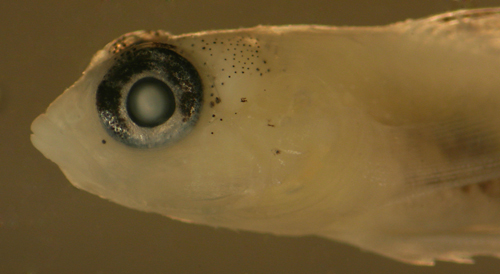 |
| |
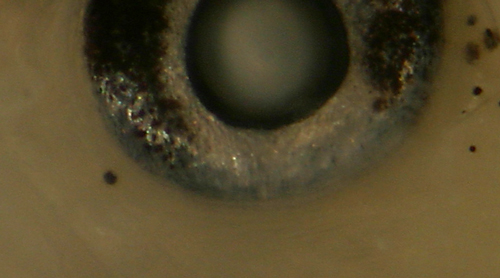 |
| |
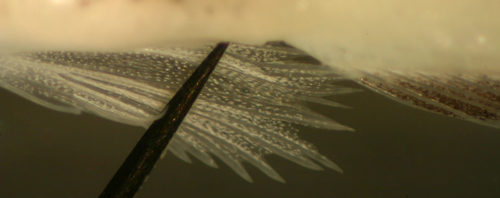 |
| |
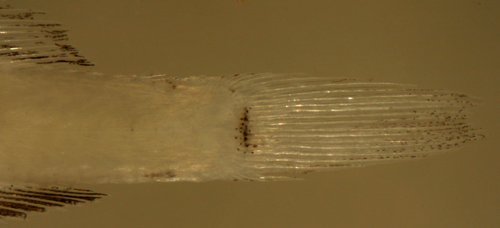 |
| Coryphopterus
thrix (top) vs. eidolon |
| |
| Colon, Panama, n7530a |
|
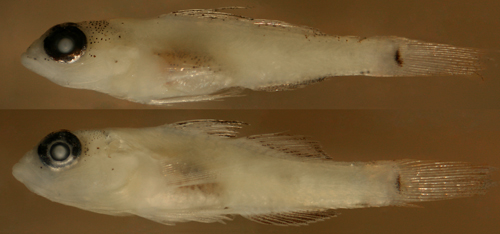 |
| Coryphopterus
thrix (top) vs. eidolon |
| |
| Colon, Panama, n7530a |
|
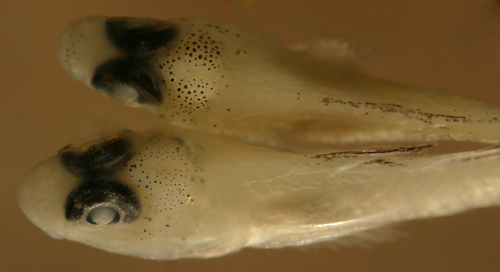 |
|
|
|
|
|
|
|
|
| Diagnosis:
Modal fin-ray counts of D-VI,10 A-10 and
Pect-18-20 with fused pelvic fins indicate the 10/10
Coryphopterus sand gobies, i.e.
Coryphopterus thrix, C.
glaucofraenum, C.
tortugae, C.
bol, C.
dicrus, and C.
eidolon. The distinguishing features of
adult
C. thrix are mostly not present
on recruits and small juveniles. |
|
| Analogues:
The 10/10 sand goby clade share fin-ray counts,
morphology, and most markings as larvae and new
recruits. C. thrix and C.
eidolon diverge early during transition
as they develop scattered spots on the top of the
head vs. stripes on most other sand gobies, prominent
melanophore(s) at the 7-8 o'clock position on the
orbital rim, and tail melanophores at the base of
the central rays (vs. ventral rays). Both species
have no jaw-angle melanophores, at least as recruits
(larval pattern uncertain). C. thrix juveniles
larger than about 12 mm SL begin to develop the
characteristic speckling of small patches of melanophores
(some 0.05-0.1 mm) over the dorsal aspect of the
eye vs. a few large round and comma-shaped patches
(0.3-0.5 mm) in C.
eidolon and other sand gobies. An additional
difference between the small juveniles (>10 mm
SL) of these two very similar species is the uniform
size of the head melanophores in C.
eidolon vs. C. thrix, where the lowest
melanophores, just behind the eye, are distinctly
larger than the adjacent sets of dorsal melanophores.
Recruits of the hovering gobies Coryphopterus
personatus, C. hyalinus, and C.
lipernes also do not have stripes on the head
at transition; nevertheless they can be distinguished
from transitional C. thrix by developing
melanophores around the vent and in a wide band
from the eye to the maxilla. |
|
| Description:
|
|
| NOTE:
Pre-transitional larvae are described above
as the 10/10 Coryphopterus spp. |
|
|
| Coryphopterus
thrix transitional recruit |
| 10.0 mm SL, |
| melanophores at 8 o'clock
on orbital rim |
| Colon, Panama, n7530a |
|
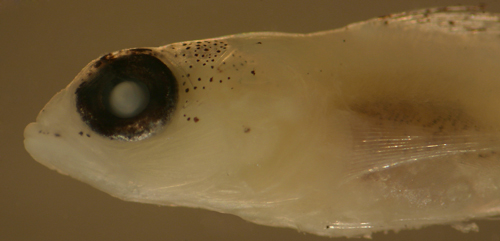 |
| Coryphopterus
thrix juvenile |
| 14.1 mm SL, DNA confirmed
ID |
| speckled upper eye,
variably-sized melanophores behind eye |
| La Parguera, Puerto
Rico, PR785a |
|
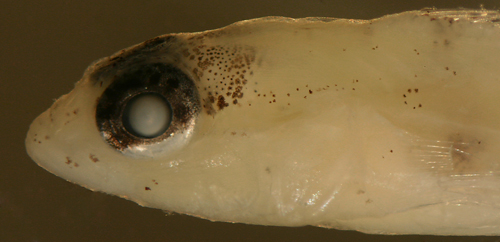 |
|
|
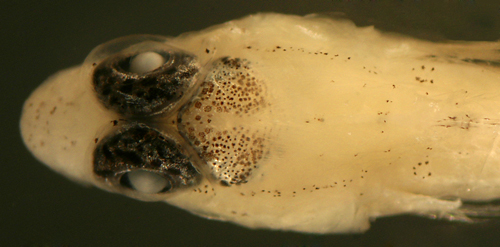 |
| |
|
| |
|
| |
|
| |
|
|
|
|
|
|
| Coryphopterus punctipectophorus |
|
|
|
|
|
|
| |
|
|
| Diagnosis:
Modal fin-ray counts of D-VI,11 A-10 and Pect-18-20
indicate Coryphopterus punctipectophorus.
Most other sand-goby congeners have 10/10, with
only a rare individual with 11 second-dorsal-fin
elements. The distinguishing features of adult
C. punctipectophorus are mostly not
present on recruits and small juveniles. |
|
| Analogues:
The sand goby clade share morphology and most markings
as larvae and new recruits. C. punctipectophorus
can best be separated by fin-ray counts (11/10)
at these early stages. C. punctipectophorus and
the other head-striped sand gobies develop short
stripes on top of the head very early in transition,
separating them from the spotted-head gobies (i.e.
C.
eidolon, C.
thrix, C.
alloides, C.
kuna, and the non-sand
Coryphopterus species). |
|
| Description:
|
|
|
|
|
|
|
|
|
|
|
| Diagnosis:
Modal fin-ray counts of D-VI,11 A-11 and
Pect-18-20 indicate Coryphopterus venezuelae.
Most other sand-goby congeners have 10/10, with
only a rare individual with 11 fin elements. C.
venezuelae has 11 elements in both the second
dorsal and anal fins. The distinguishing features
of adult
C. venezuelae are mostly not present
on recruits and small juveniles. |
|
| Analogues:
The sand goby clade share morphology and most markings
as larvae and new recruits. C. venezuelae
can best be separated by fin-ray counts (11/11)
at these early stages. C. venezuelae and
the other head-striped sand gobies develop short
stripes on top of the head very early in transition,
separating them from the spotted-head gobies (i.e.
C.
eidolon, C.
thrix, C.
alloides, C.
kuna, and the non-sand
Coryphopterus species).
Recruits of C. venezuelae appear almost identical
to C.
glaucofraenum; they diverge in transition
when C. venezuelae have a long streak at
the base of the first anal-fin rays, usually over
5-6 rays, while on C.
glaucofraenum the streak is short and covers
about 3 rays. C.
glaucofraenum (and C. venezuelae)
diverge from the other head-striped gobies (C.
tortugae, C.
bol, and C.
dicrus) as early recruits when they develop
colon-like rounded spots at the base of the caudal
fin and as melanophores form at about 7-8 o'clock
on the orbital rim extending forward in a stripe
(not obliquely down) across the upper jaw vs. at
6-7 o'clock down to the angle of the jaw in C.
tortugae and C.
bol. |
|
| Description:
Recruits develop three stripes behind the
eye with the lowest stripe extending in a straight
line across the jaw, not continuous under the eyeball
until about 14 mm SL. Notably, recruits have no
melanophores extending down from the orbital rim
at 6-7 o'clock toward the corner of the jaw. A row
of melanophores develop at the lower base of the
pectoral fin after transition and the median-fins
are heavily speckled. Two colon-like rounded spots
are present at the base of the caudal fin and rows
of X-shaped markings develop along the sides of
the body. |
|
|
| Coryphopterus
venezuelae recruit |
| 11.6 mm SL, 11/11 |
| Cumana, Venezuela,
GCRL 15947 |
|
 |
| vs. Coryphopterus
glaucofraenum recruit |
| 11.5 mm SL, 10/10 |
| Cumana, Venezuela,
, GCRL 15947 |
|
 |
|
|
|
| |
|
|
|
|
|
|
|
|
|
| Diagnosis:
Modal fin-ray counts of D-VI,10 A-8-9 and Pect-16-17
match Coryphopterus alloides, along with
a number of other regional gobies. Some Lythrypnus
species can have as many as 16 pectoral-fin
rays, but only rare individuals would have 17 (17
is frequent in C. alloides). Bathygobius
curacao can overlap the fin-ray count but
larvae have prominent internal melanophores. Coryphopterus
kuna has D-VI,9 A-9 and pect-15. Other gobies
which share the median-fin-ray count have more pectoral-fin
rays: Lophogobius
cyprinoides with 17-19 (16-20), Priolepis
hipoliti (17-19), Bathygobius
mystacium and B.
soporator (both with mode 19-20). The only
seven-spined goby with a similar modal fin-ray count
is Gobiosoma grosvenori (16-18). Some distinguishing
features of adult
C. alloides are present on recruits and
small juveniles, such as the characteristic mid-body
bar and dorsal-fin spot, however recruits do not
have the diagnostic divided pelvic fins. (DNA) |
|
| Analogues:
(VMS4: jaw angle, thorax, anal fin, caudal peduncle)
Based on the appearance of transitional recruits,
larval C. alloides likely share the VSM4
melanophore pattern. The reduced anal-fin-ray count
separates larvae from the other sand gobies. Transitional
C. alloides share a spotted head pattern
with C.
thrix and C.
eidolon vs. stripes on most other sand gobies,
as well as a prominent melanophore(s) at the 8 o'clock
position on the orbital rim (on the majority of
individuals), often early in transition. C. alloides
diverge early from C.
thrix and C.
eidolon, having the jaw angle melanophores
and the mid-body bar. |
|
| Description:
|
|
|
|
| Coryphopterus
alloides transitional recruit |
| 8 mm SL |
| bar through mid-body
and spinous dorsal |
| Colon, Panama, n7530 |
|
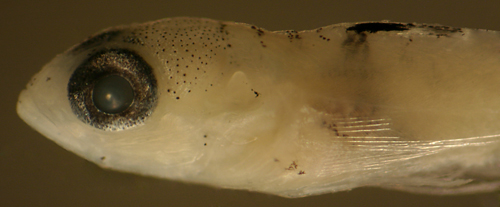 |
| |
|
| |
|
| |
|
| |
|
|
|
|
|
|
|
|
|
|
Diagnosis:
Modal fin-ray counts of D-VI,9 A-9 and
Pect-15 indicate the newly-described species Coryphopterus
kuna (Victor
2007), found widely in the Caribbean Sea:
so far recorded from Yucatan (Banco Chinchorro),
Belize, Honduras (Utila), Panama, San Andres,
Guadeloupe and Florida. The distinguishing features
of later
juvenile and adult C. kuna are mostly
not present on recruits and small juveniles.
(DNA)
|
|
| Analogues:
|
|
|
Description:
Body relatively thin, long and narrow with a large
eye and a terminal relatively small mouth. Pectoral
fins long, reaching to the level of the vent.
Pelvic fins fused at transition with no apparent
frenum, innermost pelvic-fin ray about equal to
next ray. Dorsal and anal-fin bases relatively
short, caudal peduncle long and narrowing rapidly,
5-7 procurrent caudal-fin rays (5-6 spindly).
Melanophores on the ventral midline at the isthmus
and the pelvic-fin insertion and then a row along
the anal-fin base, paired and one per side between
the third and ninth element, followed by a space
and then a row of melanophores extending along
the ventral midline of the caudal peduncle ending
near the start of the procurrent caudal-fin rays.
Internal melanophores are present around the sacculus,
at the dorsal surface of the swim bladder, and
around the gut near the vent. Along the dorsal
midline, there are melanophores along the base
of the dorsal fins: one at the first and last
dorsal spines and then at the base of each soft
dorsal-fin element. One or two melanophores are
on the body just lateral to the midline near the
base of the soft dorsal fin. Internal melanophores
are present on the head at the base of the saccule
and a deep pair at the rear of the braincase,
and then along the dorsal surface of the swim
bladder and around the gut near the vent. Transitional
larvae have a large round eye. They develop a
pattern of large discrete melanophores on the
dorsal aspect of the body, most notably three
or four large melanophores overlying the eyeball,
a triangle of three with the vertex at the anterior
midline between the eyes, several around the back
of the braincase and then a row of sometimes paired
melanophores along the dorsal midline of the body
back to the soft-dorsal-fin base. A large stripe
of iridophores extends backward on the head from
the upper eye. Melanophores develop along the
first dorsal spine and at the base of the second-dorsal-fin
elements. Note that in this larva there are no
melanophores at the angle of the jaw or on the
caudal-fin rays.
|
|
|
|
| Coryphopterus kuna
larva |
| 7.0 mm SL |
| Yucatan, Mexico, 240306 |
| coll. by Lourdes Vasquez
et al. |
|
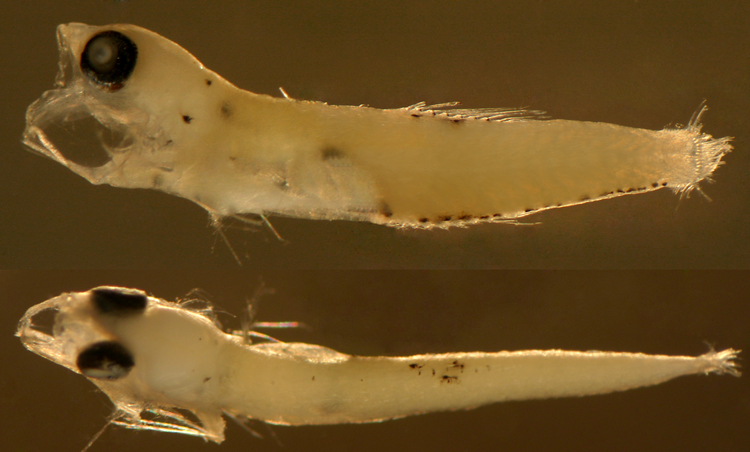 |
|
 |
| Coryphopterus kuna
transitional larva |
| 7.3 mm SL, DNA confirmed
ID |
Banco Chinchorro, Mexico
courtesy Dave Jones |
| |
|
 |
| |
 |
| |
 |
| |
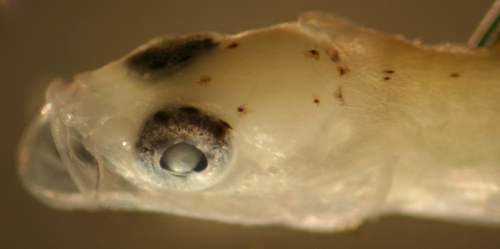 |
| |
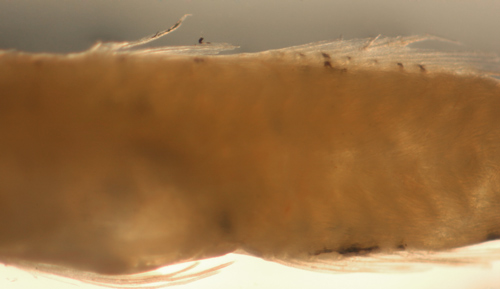 |
|
|
|
|
|
|
|
|
| Diagnosis:
Modal fin-ray counts of D-VI,10 A-10 and
Pect-16-18 indicate Coryphopterus lipernes.
The distinguishing features of later
juvenile and adult C. lipernes are mostly
not present on recruits and small juveniles.
(DNA) |
|
| Analogues:
|
|
| Description:
Body relatively thin, long and narrow with
a large eye and a terminal mouth. Paired fins medium
to long at transition, dorsal and anal-fin bases
relatively short, caudal peduncle long and narrow,
procurrent caudal-fin rays 7-10 (7-9 spindly). |
|
|
|
| Coryphopterus
lipernes + larva |
| 7.7 mm SL |
| speckled membrane above
eye |
| San Blas, Panama, SB86-825 |
|
|
| |
|
| |
|
| |
|
| |
|
|
|
|
|
|
|
|
|
| Diagnosis:
Modal fin-ray counts of D-VI,11 A-11 and
Pect-15 indicate Coryphopterus personatus.
The distinguishing features of later
juvenile and adult C. personatus are
mostly not present on recruits and small
juveniles. (DNA) |
|
| Analogues:
(VMS3: thorax, anal fin, caudal peduncle) Larval
C. personatus look much like larvae of the
typical sand goby, but are missing the melanophores
at the jaw angle and on the caudal fin. Occasional
individuals with 10/10 can be similar to rare unmarked
variants of the sand gobies; only the low pectoral-fin
ray count would be definitive. Larval C. personatus
have a larger eye than many of the sand goby larvae
with more extensive dorsal membrane stippling, although
these characters may be subtle. Transitional stage
C. personatus diverge from the two other
non-sand Coryphopterus species as follows:
from C.
hyalinus
by developing spots scattered on the top of the
head (vs. an unmarked central region) and having
rows of melanophores along the posterior dorsal
quadrant (1 to 2 o'clock) of the ocular rim (vs.
an unmarked area); from C.
lipernes by developing a prominent patch
of melanophores along the abdomen to the vent (vs.
a simple ring around the vent). As larger recruits,
C. personatus diverge from the two
other species by retaining a mostly unmarked body
(vs. speckling on the posterior half of the body). |
|
| Description:
Body relatively thin, long and narrow with
a large eye and a terminal mouth. Paired fins medium
to long at transition, dorsal and anal-fin bases
relatively short, caudal peduncle long and narrow,
procurrent caudal-fin rays 7-10 (7-9 spindly). Lightly
marked mostly along the lower body: melanophores
on the ventral midline at the isthmus and the pelvic-fin
insertion (usually streaks). Then there is a row
along the anal-fin base, usually six or often seven,
paired and one per side between the third and ninth
element (often merged into a streak on each side).
Then after a space there is a row of midline melanophores,
usually seven, sometimes eight, unpaired (but often
merged into a streak), extending along the caudal
peduncle ending near the start of the procurrent
caudal-fin rays. Internal melanophores are present
at the dorsal surface of the swim bladder and around
the gut near the vent (none on the head). Series
of transitional larvae show development of the eye
from a slightly narrowed vertical oval slightly
tilted forward with a small posterior-inferior extension
of the iris to round and notably larger. The extension
has several surface melanophores overlying it (vs.
C.
glaucofraenum, comparative photograph below).
Rare individuals show abnormal enlargements of this
extension. There is often a prominently speckled
"eyebrow" membrane over the upper half and posterior
of the eyeball that appears detached from the pigmented
iris below. Transitional larvae develop a scattering
of iridophores between the eyes and in a stripe
behind the upper eye. Melanophores start as a few
scattered on top of the head developing into a loose
cluster on the dorsal surface of the head behind
the eye (not a stripe). Melanophores later develop
in a tight group on the abdominal wall forward of
the vent. |
|
|
|
| Coryphopterus
personatus + larva |
| 7.7 mm SL |
| speckled membrane above
eye |
| San Blas, Panama, SB86-825 |
|
 |
| |
 |
| |
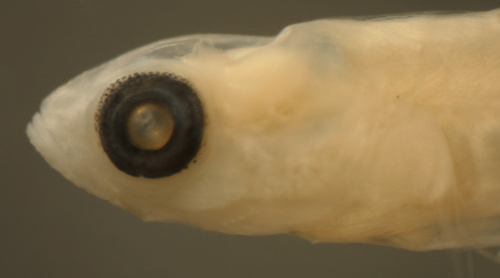 |
| |
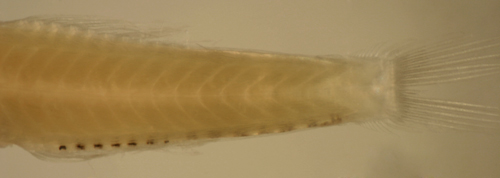 |
| |
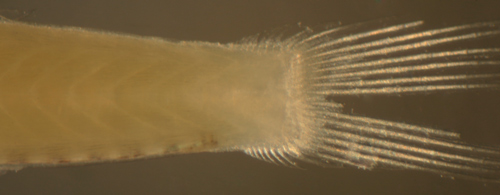 |
| Coryphopterus
personatus + larva |
6.5 mm SL (upper)
vs. C.
glaucofraenum 6.7 mm SL (lower) |
| note eye larger top
to bottom vs. head depth |
| San Blas, Panama, SB86-805 |
|
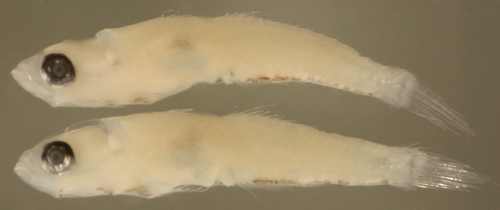 |
| |
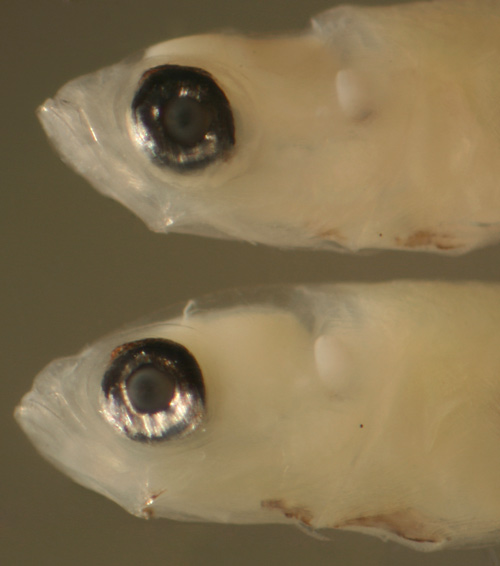 |
| Coryphopterus
personatus + larva |
7.0 mm SL (upper)
vs. C.
glaucofraenum 7.0 mm SL (lower) |
| note melanophores over
iris extension |
| San Blas, Panama, SB86-1103 |
|
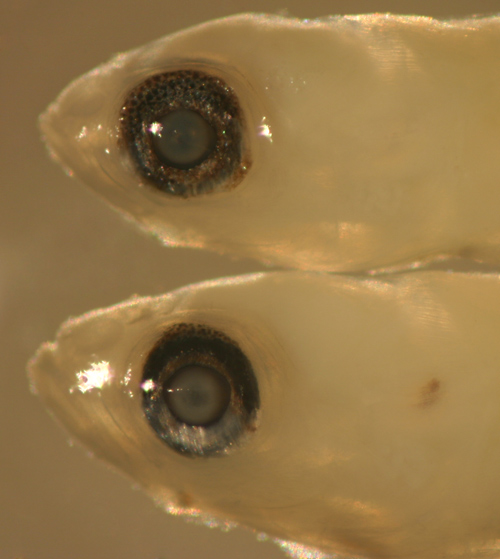 |
| Coryphopterus
personatus + larva |
| 7.6 mm SL, |
| fused pelvic fins,
note uniting membrane |
| San Blas, Panama, SB86-805 |
|
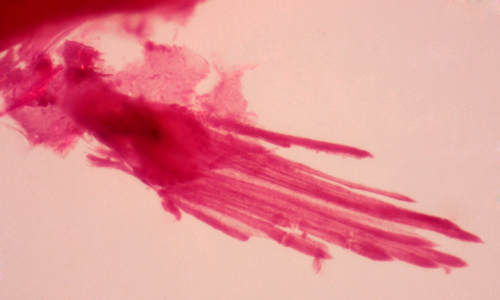 |
| |
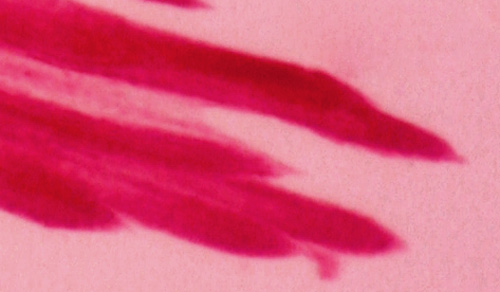 |
| Coryphopterus
personatus pelagic larva |
| 5.4 mm SL |
| DNA ID |
| USA |
|
 |
| |
 |
| Coryphopterus
personatus + larva |
| 7.4 mm SL |
| round eye and lightly
marked |
| San Blas, Panama, SB84-522 |
|
 |
| |
 |
| Coryphopterus
personatus + larva |
| 7.3 mm SL |
| deeper-bodied variant |
| San Blas, Panama, SB84-527a |
|
 |
| |
 |
| Coryphopterus
personatus + larva |
| 7.2 mm SL |
| iris extension abnormality |
| San Blas, Panama, SB87-119 |
|
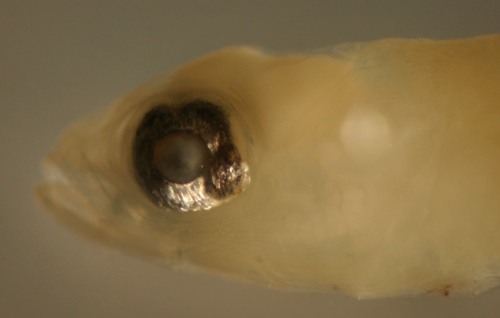 |
| C.
personatus + early transitional larva |
| 7.9 mm SL |
| iridescent head stripe |
| San Blas, Panama, SB84-624a |
|
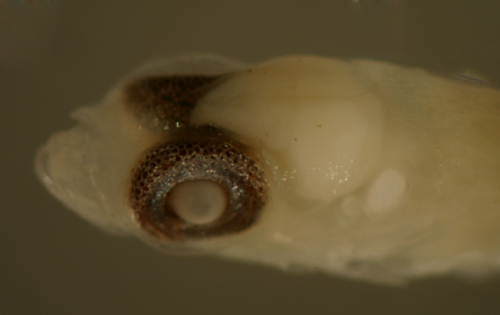 |
| C.
personatus + transitional larva |
| 8.1 mm SL |
| diagnostic abdominal
melanophore patch |
| San Blas, Panama, SB83-151 |
|
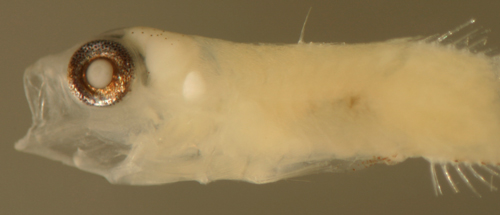 |
| |
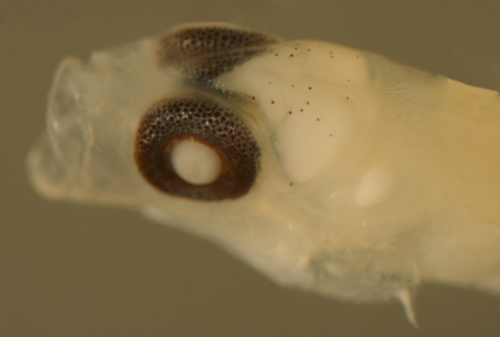 |
| C.
personatus + transitional larva |
| 7.8 mm SL |
| melanophores on membrane
over eyeball |
| San Blas, Panama, SB86-1031 |
|
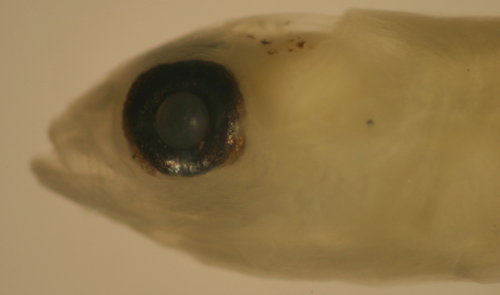 |
| C.
personatus transitional recruit (above) |
| C.
hyalinus transitional recruit (below) |
| 7.9 and 7.0 mm SL,
DNA confirmed ID |
| St. Thomas, USVI, ST506 |
| Utila, Honduras, U8703 |
|
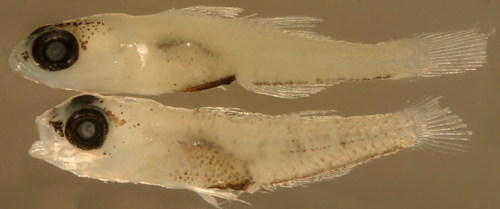 |
| C.
personatus transitional recruit (above) |
| C.
hyalinus transitional recruit (below) |
| 8.0 and 8.4 mm SL,
DNA confirmed ID |
| St. Thomas, USVI, ST506 |
| Utila, Honduras, U8703 |
|
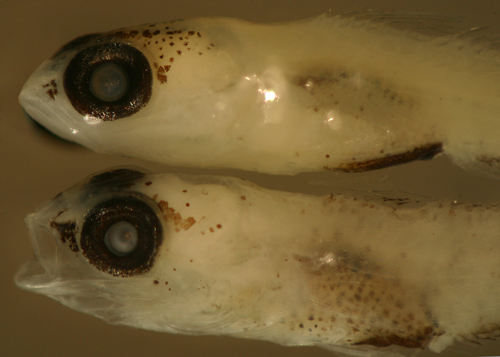 |
| C.
personatus transitional recruit (above) |
| C.
hyalinus transitional recruit (below) |
| 8.0 and 8.4 mm SL,
DNA confirmed ID |
| St. Thomas, USVI, ST-506 |
| Utila, Honduras, U8703 |
|
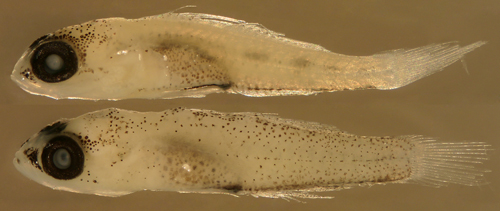 |
| C.
personatus transitional recruit (above) |
| C.
hyalinus transitional recruit (below) |
| 8.0 and 8.4 mm SL,
DNA confirmed ID |
| St. Thomas, USVI, ST-506 |
| Utila, Honduras, U8703 |
|
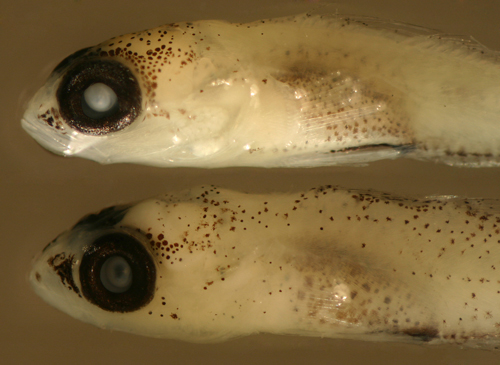 |
| Coryphopterus
personatus recruit |
| 8.6 mm SL |
| St. Thomas, USVI, |
|
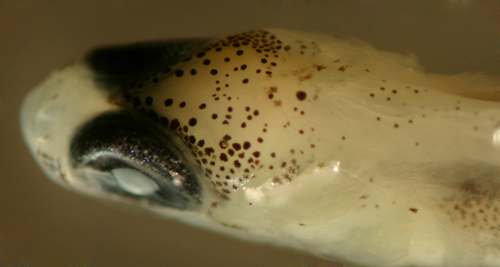 |
|
|
|
|
|
|
|
|
| Diagnosis:
Modal fin-ray counts of D-VI,10 A-10 and
Pect-15 indicate Coryphopterus hyalinus.
The distinguishing features of later
juvenile and adult C. hyalinus are mostly
not present on recruits and small juveniles.
(DNA)
|
|
| Analogues:
(VMS3: thorax, anal fin, caudal peduncle) Larval
C. hyalinus look much like larvae of the
typical sand goby, but are missing the melanophores
at the jaw angle and on the caudal fin. They can
be similar to rare unmarked variants of the sand
gobies; only the low pectoral-fin ray count would
be definitive. Larval C. hyalinus have a
larger eye than many of the sand goby larvae with
more extensive dorsal membrane stippling, although
these characters may be subtle. C. hyalinus
diverge from congeners at transition when they develop
an unmarked central region on the top of the head
vs. a collection of spots or stripes on the others.
They diverge later in transition from the two other
non-sand Coryphopterus species as follows:
from C.
personatus by developing no rows of melanophores
along the posterior dorsal quadrant (1 to 2 o'clock)
of the ocular rim and from C.
lipernes by developing a prominent patch
of melanophores along the abdomen to the vent (vs.
a simple ring around the vent). As larger recruits,
C. hyalinus diverge from the former by developing
extensive speckling on the posterior half of the
body (vs. little to none) and from the latter by
having the speckling somewhat equal above and below
the lateral line (vs. mostly above the line). |
|
| Description:
Body relatively thin, long and narrow with
a large eye and a terminal mouth. Paired fins medium
to long at transition, dorsal and anal-fin bases
relatively short, caudal peduncle long and narrow,
procurrent caudal-fin rays 7-10 (7-9 spindly). Lightly
marked mostly along the lower body: melanophores
on the ventral midline at the isthmus and the pelvic-fin
insertion (usually streaks). Then there is a row
along the anal-fin base, usually six or often seven,
paired and one per side between the third and ninth
element (often merged into a streak on each side).
Then after a space there is a row of midline melanophores,
usually seven, sometimes eight, unpaired (but often
merged into a streak), extending along the caudal
peduncle ending near the start of the procurrent
caudal-fin rays. Internal melanophores are present
at the dorsal surface of the swim bladder and around
the gut near the vent (none on the head). Series
of transitional larvae show development of the eye
from a slightly narrowed vertical oval slightly
tilted forward with a small posterior-inferior extension
of the iris to round and notably larger. The extension
has several surface melanophores overlying it (vs.
C.
glaucofraenum, comparative photograph below).
Rare individuals show abnormal enlargements of this
extension. There is often a prominently speckled
"eyebrow" membrane over the upper half and posterior
of the eyeball that appears detached from the pigmented
iris below. Transitional larvae develop a scattering
of iridophores between the eyes and in a stripe
behind the upper eye. Melanophores start as a few
scattered on top of the head developing into a loose
cluster on the dorsal surface of the head behind
the eye (not a stripe). Melanophores later develop
in a tight group on the abdominal wall forward of
the vent. |
|
|
|
| Coryphopterus
hyalinus transitional recruits |
| 7.0, 6.9, and 7.3 mm
SL |
| Utila, Honduras, U8703 |
|
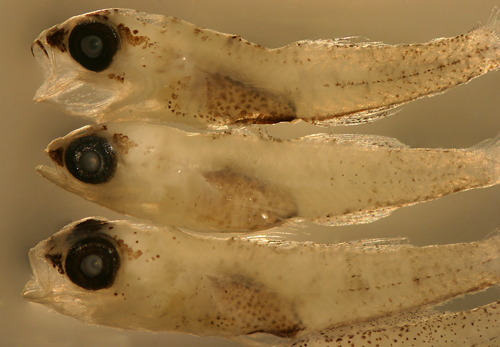 |
| Coryphopterus
hyalinus transitional recruits |
| 7.0 and 6.9 mm SL |
| note eye membrane stippling
at transition |
| Utila, Honduras, U8703 |
|
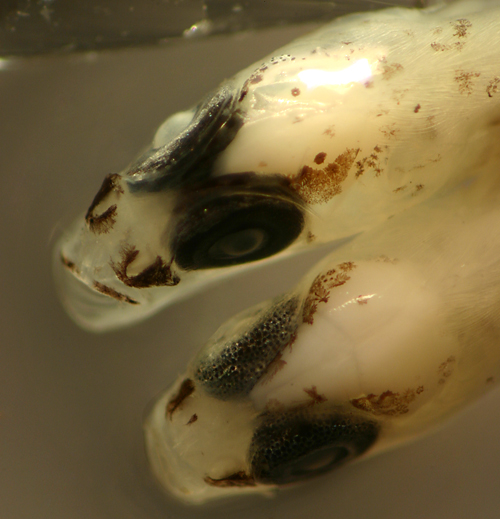 |
| Coryphopterus
hyalinus recruit |
| 8.4 mm SL |
| Utila, Honduras, U8703 |
|
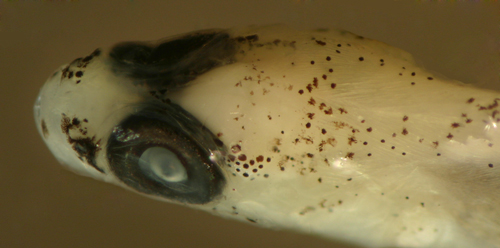 |
|
|
|
|
|
|
Lythrypnus vs.
Coryphopterus |
|
|
|
|
|
|
| |
| |
|
|
| The
larvae of the two most common genera in this group,
Lythrypnus
and Coryphopterus,
are quite similar and the two sets of species can
be difficult to distinguish. Nevertheless, it is
possible to separate the larvae of the two genera
by fin-ray counts, melanophore patterns, and, to
a lesser degree, morphology and size at transition. |
|
| fin-ray
counts: One distinctive difference between
the two genera is that most Lythrypnus
have one fewer anal-fin ray than dorsal-fin
ray, while most Coryphopterus
have equal numbers (C.
alloides and C.
punctipectophorus are exceptions). In addition,
Lythrypnus
have 9, sometimes 8, anal-fin elements,
lower than for all Coryphopterus
except for C.
kuna, C.
alloides and a rare C.
eidolon. Lastly, Lythrypnus
have only 14-16 pectoral-fin rays, fewer
than all of the Coryphopterus
other than C.
kuna and Coryphopterus
personatus/hyalinus (both of which share
the count of 15) and C.
alloides, which often have 16. |
|
| On
close examination, there are generally fewer procurrent
caudal-fin rays in larval Lythrypnus:
5 or 6 vs. 8 or 9 in most larval Coryphopterus
The photograph below shows 5-6 procurrent
caudal-fin rays in a 6.1 mm SL larval Lythrypnus
sp. The procurrent rays are small, spindly,
and not segmented, the other rays are thickened
and have vertical breaks dividing the rays into
segments (square-ended rays are broken at a segment
division). |
|
|
| Size
and Morphology: If the collection consists
of only late-stage larvae (as do collections made
over the reef), the most useful practical method
of separation is body length: the Lythrypnus
larvae transform at a smaller size, about
5.5 to 6.2 mm SL (vs. 6.3 to 8.0 mm SL in Coryphopterus
). There is certainly some overlap in size
when large series of larvae are compared, but the
larvae at the small end of the range for Coryphopterus
are typically more narrow-bodied than the
Lythrypnus
larvae of the same size. The body-width
difference is most pronounced at the level of the
vent (the photograph below shows a narrow-bodied
5.1 mm SL larval Coryphopterus
sand goby above a wider-bodied 5.6 mm SL
laval Lythrypnus
sp.) For larger "average-sized" larvae there
are illustrations below in the species descriptions.
Note, however, that this paragraph considers only
the species thus far identified; the addition of
other species may obscure the size difference. |
|
| A useful
difference that applies most of the time is that
the larvae of Coryphopterus
tend to be hunched-over while most Lythrypnus
larvae are straight. In general, if one extends
the midline of the tail region forward, the eye
is mostly below the line in Coryphopterus
and mostly above the line in Lythrypnus
larvae. Hunched-over Lythrypnus larvae
do occur (see below). On closer examination, Lythrypnus
larvae tend to be wider-bodied, especially
at the level of the vent and the caudal peduncle,
and have a shorter tail; i.e. the distance from
the last dorsal ray to the base of the caudal fin
is relatively shorter. |
|
|
| Melanophore
Patterns: Fortunately, the most common larval
types mostly separate out by a simple algorithm.
Larval Lythrypnus
have a melanophore at the angle of the
jaw but no melanophores at the caudal-fin base.
Larval
Coryphopterus sand-gobies usually have both,
while larval C.
personatus have neither. For example, the
photograph below shows the typical ventral melanophore
pattern of Lythrypnus
(upper two, small and large specimens),
Coryphopterus
sand gobies (third from top, with caudal-fin
melanophores) and C.
personatus (lowest, with neither). Lastly,
larval Lythrypnus
have a characteristic deep thoracic melanophore
beneath the pelvic girdle. Although not always visible,
it often manifests itself as a deep extension of
the surface melanophore at the pelvic-fin base.
A few individuals of Lythrypnus
will have a midline melanophore just after
the last dorsal-fin ray or on the base of the lower
caudal-fin rays (markings typical of Coryphopterus
sand-goby larvae), however the morphological
differences and fin-ray counts should then be able
to differentiate between the two. |
|
|
| Six
vs. Seven-Spined Gobies: There are many similarities
in markings between the two common genera of six-spined
gobies discussed here and the Elacatinus/Gobiosoma
group of seven-spined gobies. The simplest
and most easily visible difference is that the streak
or row of melanophores on the ventral caudal peduncle
of these six-spined gobies extends almost to the
start of the procurrent caudal-fin rays, while the
seven-spined gobies have only one spot or have a
streak or row ending well before the procurrent
caudal-fin rays (photograph below of the streak
extending full length on a 7.7 mm SL larval Coryphopterus
personatus larva). In addition, most of
the six-spined larvae have a melanophore at the
angle of the jaw, which I have not found (so far)
in any of the Elacatinus/Gobiosoma
group. Some uncommon forms of Lythrypnus
larvae with reduced caudal peduncle melanophores,
e.g. forms C and D, can resemble Elacatinus/Gobiosoma
larvae, but still have six first-dorsal-fin
spines and the melanophore at the angle of the jaw,
which is present on all larval Lythrypnus
I have examined. |
|
|
|
|
|
|
|
|
|
|
| Diagnosis:
Modal fin-ray counts of D-VI,10 A-9 and Pect-15
(often 16) match Lythrypnus as well
as several other goby species. Bathygobius
curacao can overlap the fin-ray counts
but has a heavily-marked larval stage. Coryphopterus
alloides shares the median-fin-ray
count but has an equal incidence of 16 and
17 pectoral-fin rays (adults have divided
pelvic fins with no frenum, but that is likely
not apparent on larvae). C.
kuna shares the 15 pectoral-fin rays
but has equal numbers of dorsal and anal soft
rays (D-VI,9 A-9) and often dorsal head and
body markings. Other gobies which share the
median-fin-ray count but have more pectoral-fin
rays include Lophogobius
cyprinoides 17-19 (16-20), Priolepis
hipoliti (17-19), Bathygobius
mystacium and B.
soporator (both with mode 19-20).
The only seven-spined goby coming close to
the fin-ray count is Gobiosoma grosvenori
(16-18). |
|
|
There are many regional Lythrypnus
species and their ranges are not well-understood
and they may include geographic variants of
the widespread L. nesiotes. It is likely
that these species all appear similar or identical
as larvae. Up to seven species could be present
at most locations, making DNA sequencing necessary
to reliably identify larvae to species. L.
phorellus is primarily found from Florida
northwards and L. mowbrayi was first
described as the Bermuda sibling of L.
nesiotes. L. nesiotes and L.
crocodilus are widespread, co-occur with
some habitat isolation, and differ only slightly
in markings (L. nesiotes has dark bars
wider than light bars). Other species with
a mode of 15 pectoral-fin rays (but often
having 14) include L. heterochroma, L.
elasson, and the tiny and elusive L.
minimus. L. okapia has fewer rays,
i.e. a mode of 9 dorsal-fin elements, 8 anal-fin
elements and 14 pectoral-fin rays (but rare
individuals of the other species also have
this fin-ray count). L. spilus has
a mode of 16 pectoral-fin rays. |
|
| Note:
There is extensive variation in body shape
and melanophore patterns in this laval type.
Since all fin-ray counts can overlap extensively
in this genus, it is unclear whether this
variation indicates different species or variation
during transition. There are three basic forms
of these larvae, but intermediates occur and
I cannot separate them as larval types. The
most common form has four or five melanophores
in the row along the anal-fin base and about
seven melanophores in the row along the ventral
midline of the caudal peduncle. The anal-fin
row is about half the length of the caudal
peduncle row. Less common is a "short
anal" variant with a shorter row of anal-fin
base melanophores, two or three, but often
just a short streak that is clearly less than
half the length of the caudal peduncle row.
The caudal peduncle row is also often reduced
in this type. Lastly, there is a "five
spot" variant with only about five total
melanophores along the anal fin and the caudal
peduncle, and the anal-fin base melanophores
are widely-spaced. Some of these have typical
medium-sized round eyes but some are hunched-over
and have larger eyes. It is possible that
the reduction in melanophores is part of transition,
but it does not seem to correlate with the
development of metamorphic melanophores (however
this would not be unusual in larval gobies). |
|
| Analogues:
Tail with full ventral streak |
|
| Description:
Body relatively thin, long and narrow
with a medium to large eye and a terminal
mouth. Pectoral and pelvic fins long, reaching
beyond the vent as transition approaches,
dorsal and anal-fin bases relatively short,
caudal peduncle long and narrowing rapidly,
procurrent caudal-fin rays 5-7 (5, sometimes
6, spindly). Lightly marked mostly along the
lower body: melanophores on the ventral midline
at the isthmus and the pelvic-fin insertion
(usually streaks). The latter melanophore
often appears to extend deep into the body.
Then there is a row along the anal-fin base,
usually four or five, paired and one per side,
between the third and eighth element, often
merged into a streak on each side (less common
forms have only two or three melanophores
along the anal-fin base, but there are intermediate
individuals). Then, after a space, there is
a row of midline melanophores, usually seven
unpaired (but often merged into a streak),
extending along the caudal peduncle ending
near the start of the procurrent caudal-fin
rays (the reduced-melanophore forms have only
three or four). In addition, all individuals
have a melanophore at the angle of the jaw,
at very least on one side. Rare individuals
have a single midline melanophore just after
the last dorsal-fin ray or a single melanophore
on the base of the lower segmented caudal-fin
rays. Internal melanophores are present in
the head at the base of the saccule and at
the dorsal surface of the swim bladder and
around the gut near the vent. There is a characteristic
deep thoracic melanophore beneath the base
of the pelvic fin, often merged into the surface
melanophore at the pelvic-fin base. Series
of transitional larvae show development of
the eye from a markedly narrowed vertical
oval, often tilted forward and often with
a dorsal indentation in the iris, with a small
posterior-inferior extension of the iris (usually
covered with surface melanophores) to medium-sized
and round and then becoming much larger at
the end of transition. On the oval eyes, there
is often a small speckled "eyebrow" membrane
over the anterior-superior lobe of the eyeball
that appears detached from the pigmented iris
below. Unlike several other goby larval types,
this membrane is not obvious on the later
rounded eyeball. The pectoral and pelvic fins
become distinctly longer through transition.
Transitional larvae develop seven bars of
melanophores radiating outwards from the orbit,
beginning with the bar to the mid-upper jaw. |
|
|
|
| Lythrypnus
sp. larvae |
6.0 mm SL (top),
6.4 mm SL (middle)
vs. C.
glaucofraenum 6.5 mm SL (below) |
| San Blas, Panama,
SB86-805 |
|
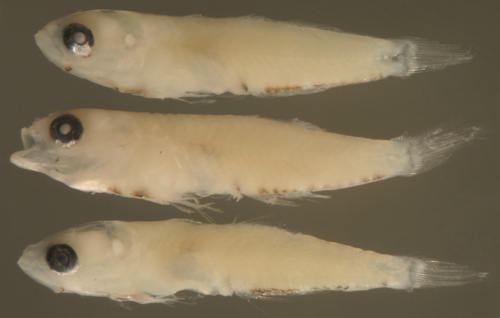 |
| |
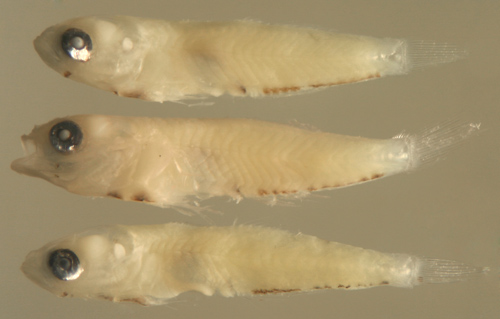 |
| Lythrypnus
sp. larvae |
| 6.0 and 6.4 mm
SL |
| transitional
eye changes |
| San Blas, Panama,
SB86-805 |
|
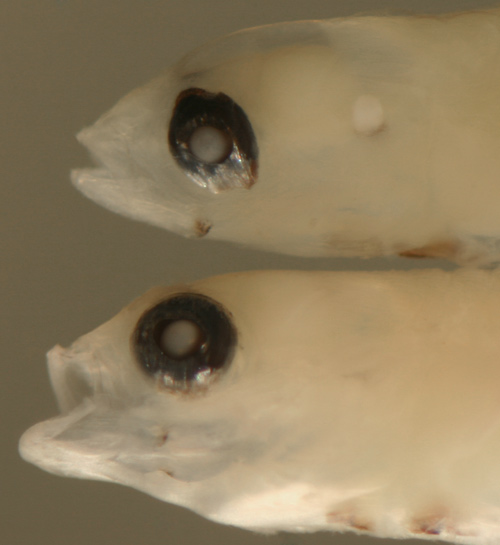 |
| Lythrypnus
sp. larva |
| 5.6 mm SL |
| San Blas, Panama,
SB86-1103 |
|
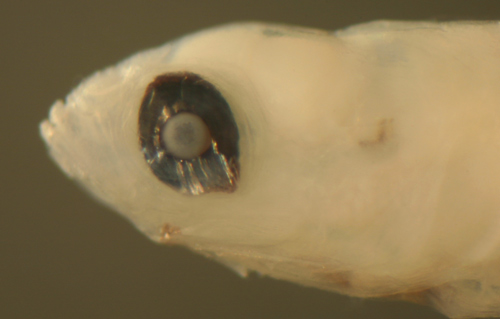 |
| Lythrypnus
sp. larva |
| 6.5 mm SL |
variant with
melanophore only
at lower eye extension |
| San Blas, Panama,
SB86-825 |
|
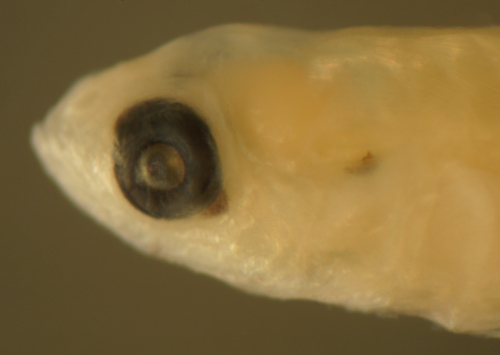 |
| Lythrypnus
sp. larva |
| 5.9 mm SL |
| internal melanophores |
| San Blas, Panama,
SB86-000 |
|
 |
| Lythrypnus
sp. larva |
| 5.9 mm SL |
| note deep thoracic
melanophore |
| San Blas, Panama,
SB86-1029 |
|
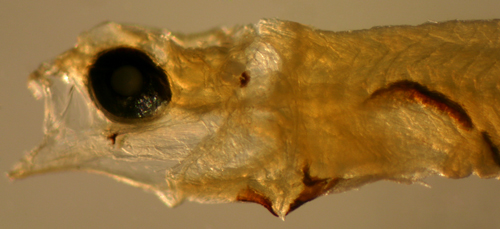 |
| |
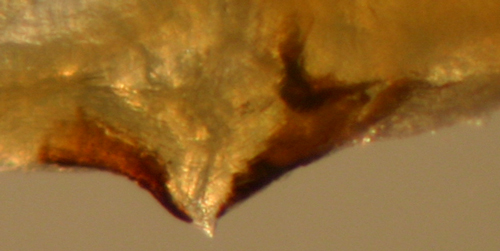 |
| Lythrypnus
sp. larva |
| 6.0 mm SL |
| D-VI,10 A-9 Pect-16,
deep thoracic |
| melanophore,
5 procurrent caudal rays |
| San Blas, Panama,
SB86-516 |
|
 |
| |
 |
| Lythrypnus
sp. larva |
| 5.5 mm SL |
| five spot variant |
| San Blas, Panama,
SB86-806 |
|
 |
| |
 |
| |
 |
| Lythrypnus
sp. transitional larva |
| 5.7 mm SL |
| five spot variant |
| San Blas, Panama,
SB86-1121 |
|
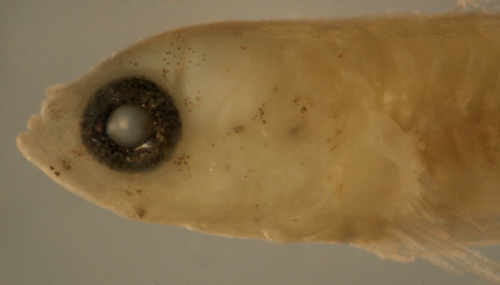 |
| |
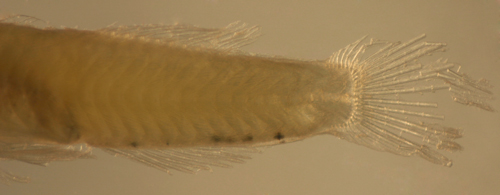 |
| Lythrypnus
sp. larva |
| 5.5 mm SL |
| five spot variant,
large eye |
| San Blas, Panama,
SB84-624a |
|
 |
| |
 |
| Lythrypnus
sp. larva |
| 6.1 mm SL |
variant with
melanophore after the last
dorsal-fin ray; D-VI,10 A-9 Pect-16 |
| San Blas, Panama,
SB86-426 |
|
 |
| |
 |
| Lythrypnus
nesiotes transitional recruit |
| 6.7 mm SL |
| San Blas, Panama,
SB80-095 |
|
 |
| |
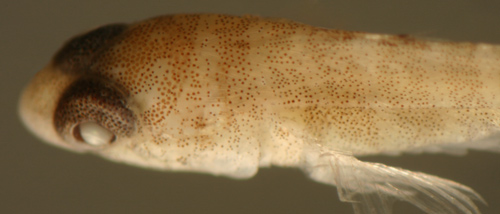 |
| Lythrypnus
cf nesiotes juvenile |
| 12.4 mm SL |
| does not key
to any in Greenfield 1988 |
| Noronha, Brazil,
FN-01 |
|
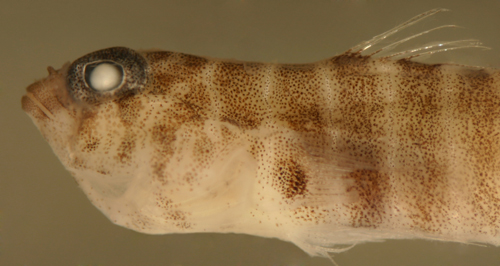 |
|
|
|
|
|
|
|
|
|
|
|
| Diagnosis:
An individual larva with the fin-ray count of D-VI,11
A-9 and Pect-15 does not fit the typical count on
any Caribbean goby, but there are many species with
10/9. Most of those, however, have many more than
15 pectoral-fin rays. Only Lythrypnus, a
few Coryphopterus, and Bathygobius
curacao have as few as 15 pectoral-fin rays
(the latter has a very different larva and can be
excluded). This larva resembles Lythrypnus
and Coryphopterus larvae in form and markings,
in particular the melanophore at the angle of the
jaw and the ventral caudal peduncle row of melanophores
extending to the start of the procurrent caudal-fin
rays. Coryphopterus
kuna has 15 pectoral-fin rays, but usually
9/9, and different larval markings. C.
alloides can rarely have 15 pectoral fin
rays (usually 16-17, with 10/9) and cannot be excluded.
C.
personatus and C.
hyalinus also have15 pectoral-fin rays,
but almost always equal numbers of second dorsal
and anal-fin elements (11/11 or sometimes 10/10,
not 11/9). Furthermore, this larva has a prominent
melanophore at the angle of the jaw that is characteristically
missing in all larval C.
personatus and C.
hyalinus. This larva has 6-8 procurrent
caudal-fin rays, intermediate between the usual
Lythrypnus and Coryphopterus. Rare
individuals of otherwise typical Lythrypnus
larvae described above can have 11/9 elements and
some individuals have deep extensions of the midline
melanophore around the pelvic-fin base, although
not in the same location as in this larva. A linear
internal melanophore above the pelvic girdle, perhaps
along the ventral postcleithrum, is characteristic
of some eleotrids (Eleotris
and Erotelis
smaragdus), but no other larval gobies.
Given the co-occurrence of the unusual fin-ray count,
the linear cleithral melanophore, and the large
size of this larva compared to the other Lythrypnus
larvae (7.9 mm SL vs. never more than 7.0 mm
SL in a large sample), it is assigned to its own
larval type. |
|
| Analogues:
|
|
| Description:
Body relatively thin, long and narrow with a large
eye and a terminal mouth. Paired fins medium length,
dorsal and anal-fin bases relatively short and unequal
(dorsal-fin base about 50% longer than anal-fin
base), caudal peduncle long and narrowing sharply,
procurrent caudal-fin rays 6-8 (6-7 spindly). Lightly
marked mostly along the lower body: melanophores
on the ventral midline at the isthmus and forward
of the pelvic-fin insertion, in a short row along
the anal-fin base, two or three (paired and one
per side) between the third and sixth element, and
then a streak of seven or eight unpaired melanophores
along the ventral midline of the caudal peduncle
ending near the start of the lower procurrent caudal-fin
rays. Head melanophores are present only at the
angle of the jaw. Internal melanophores are present
around the sacculus and along the dorsal surface
of the swim bladder and around the gut near the
vent. In this larva there is a prominent linear
internal melanophore along the ventral postcleithrum
(above the pelvic girdle). The eye is round in this
specimen. |
|
|
|
| Goby
223 larva |
| 7.9 mm SL |
| San Blas, Panama, SB87-223 |
|
 |
| |
 |
| |
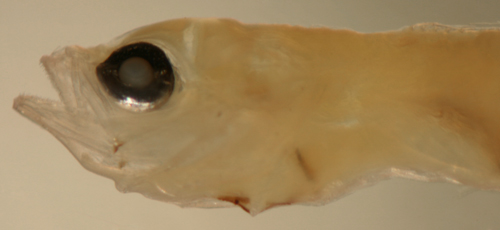 |
| |
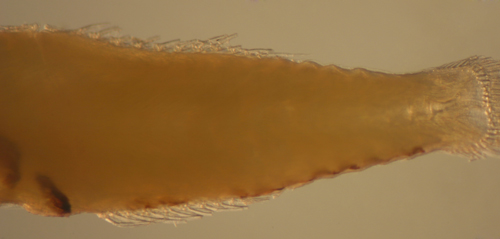
|
|
|
|
|
 |
|
All contents © copyright 2006-2013
All rights reserved
www.coralreeffish.com by
Benjamin Victor
|
|
|
|
|
|
|